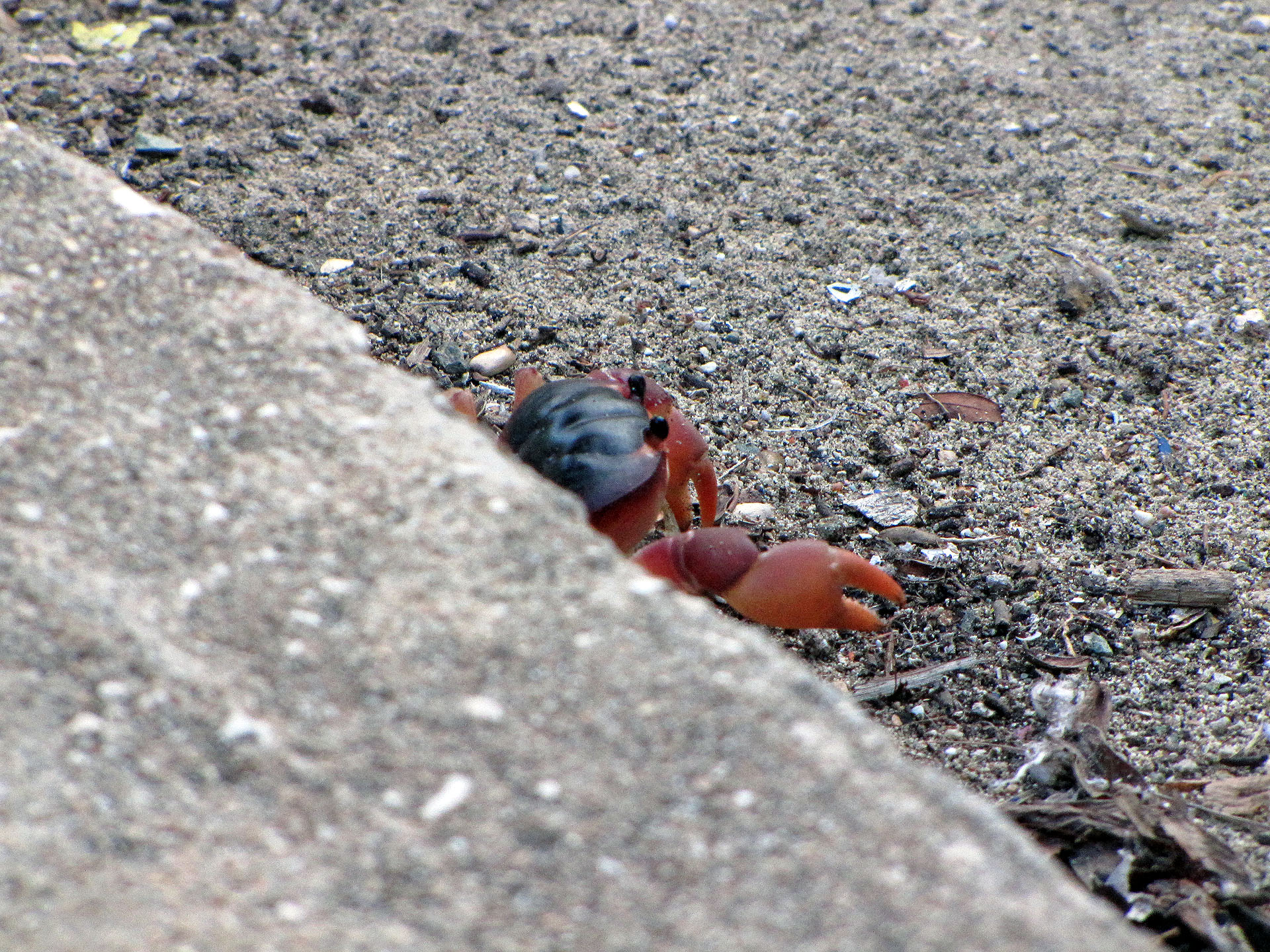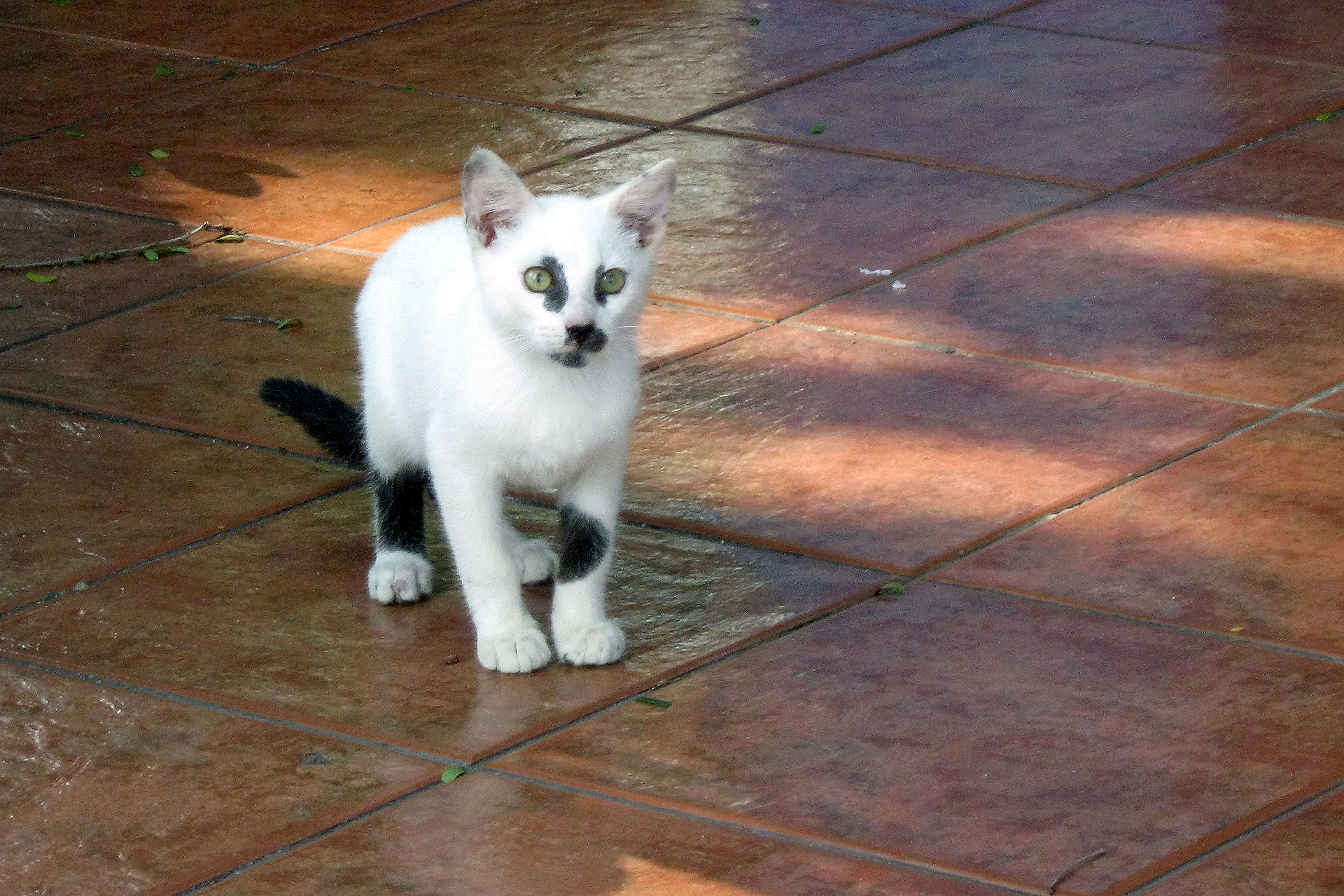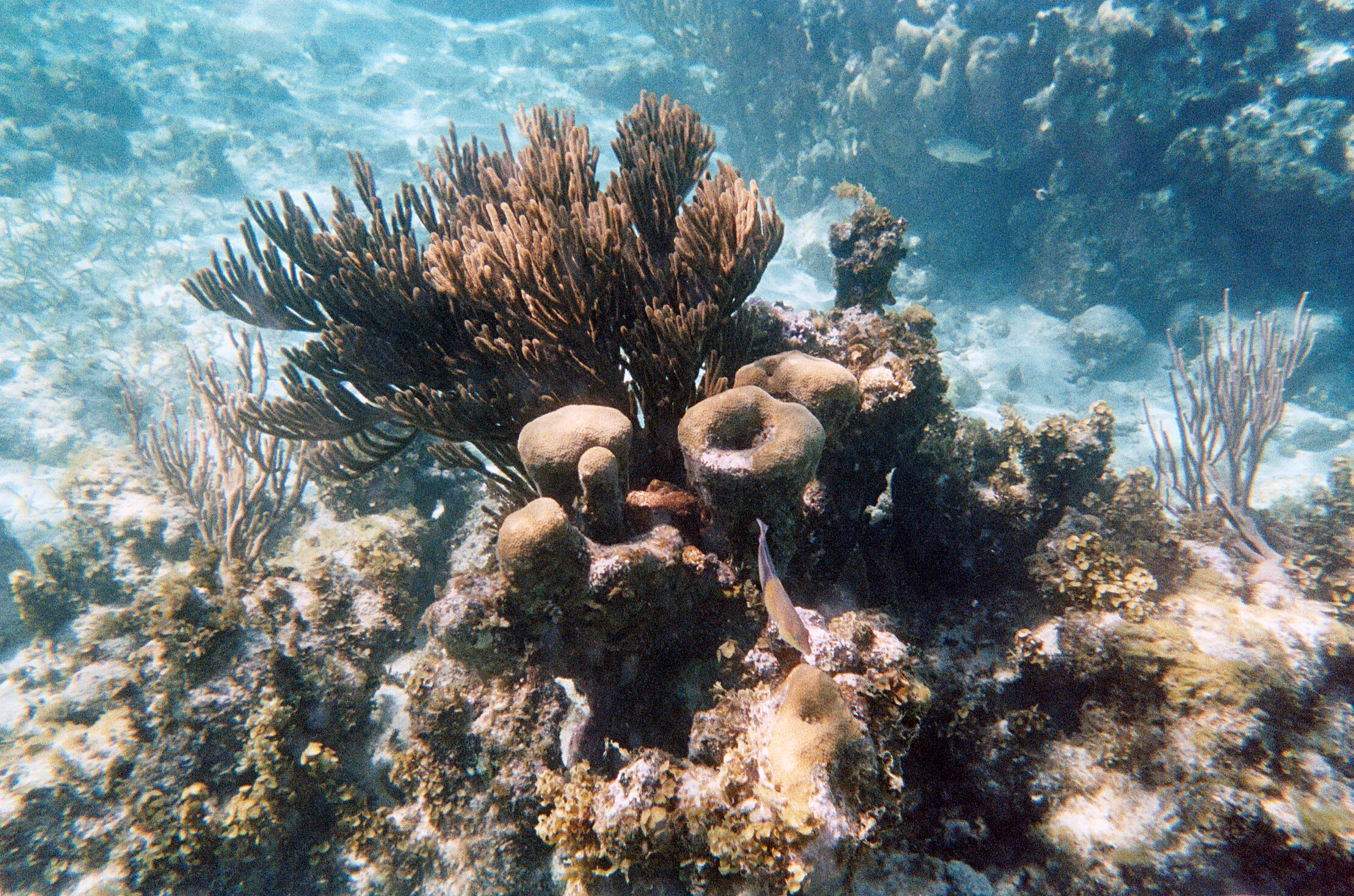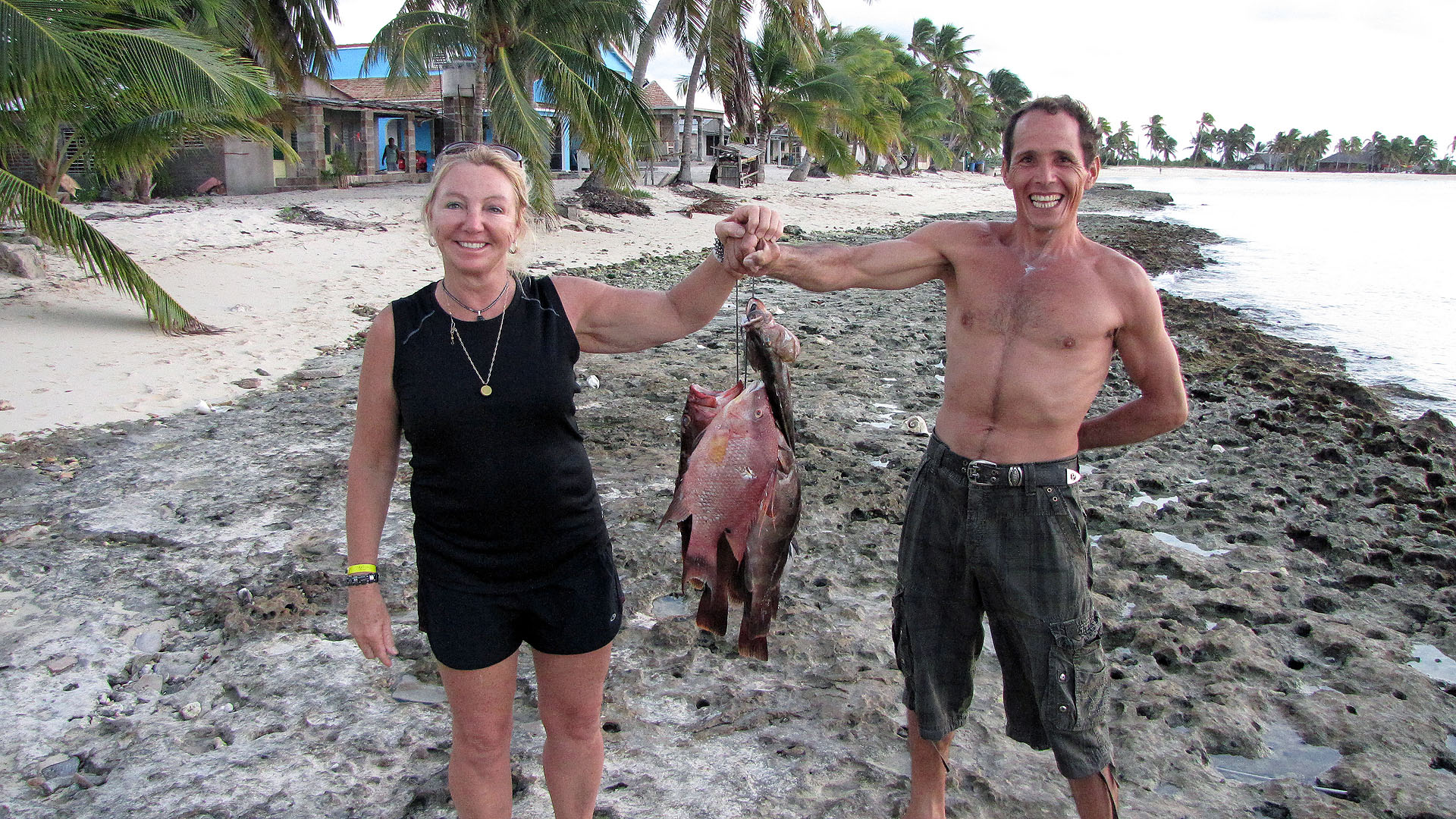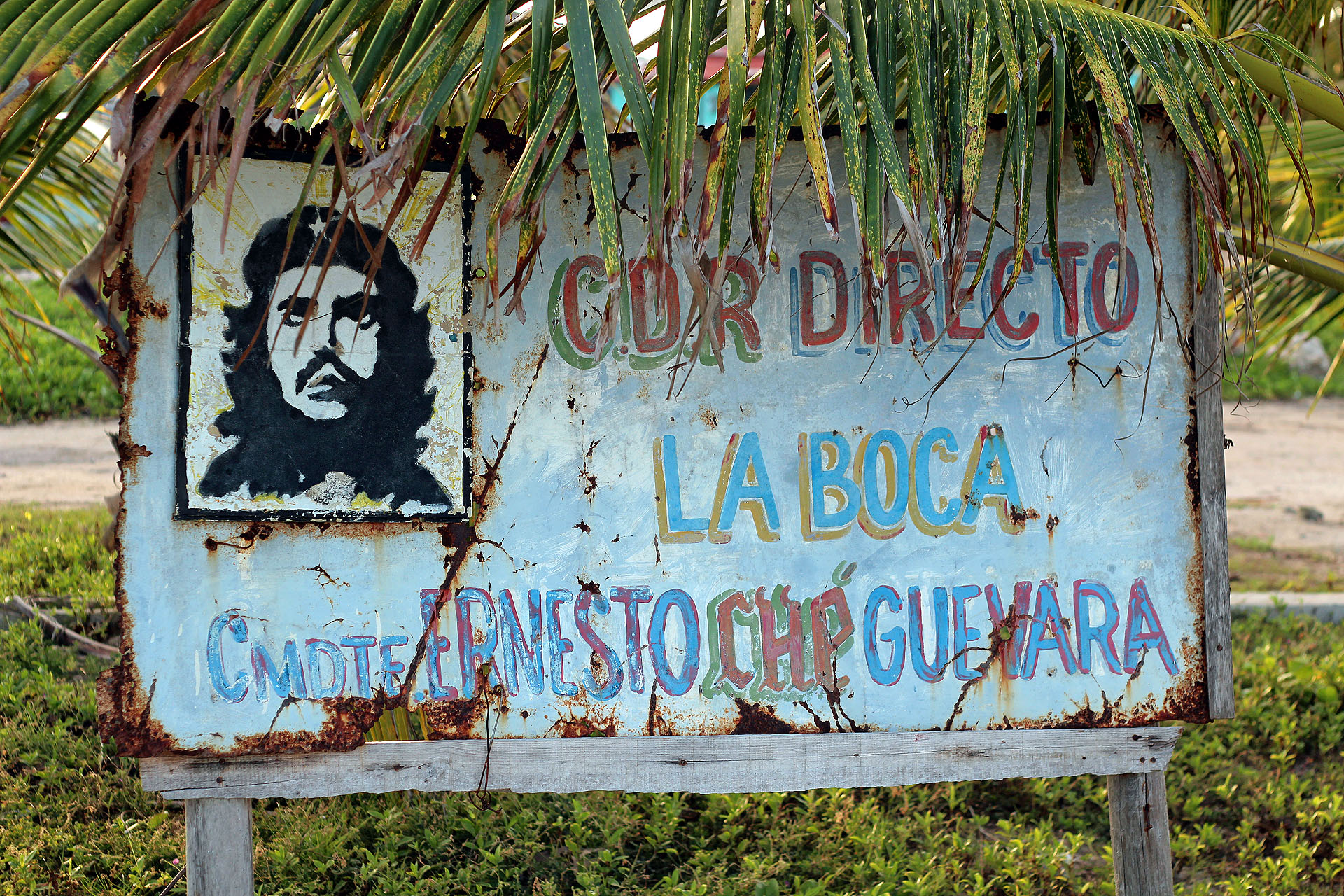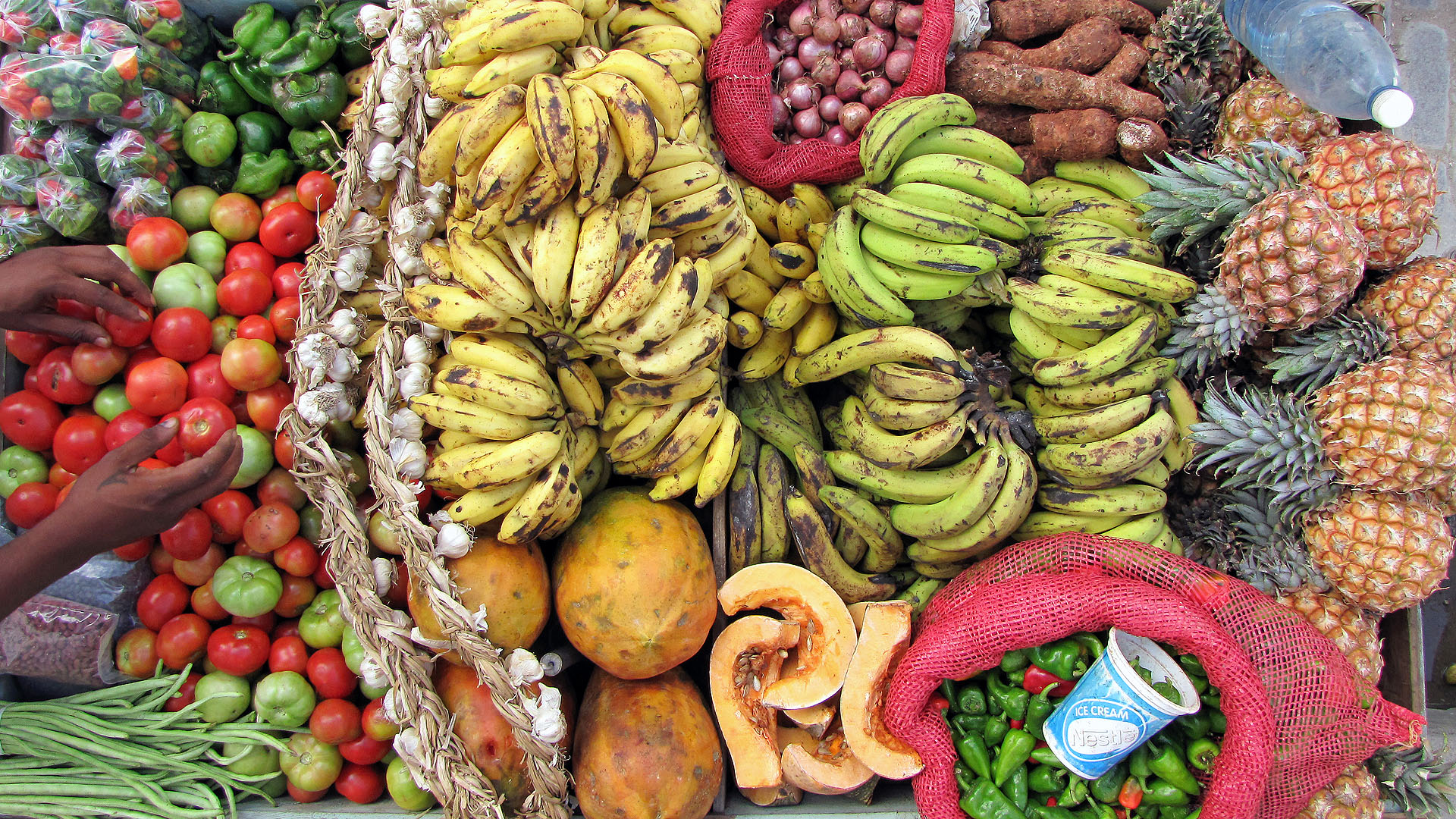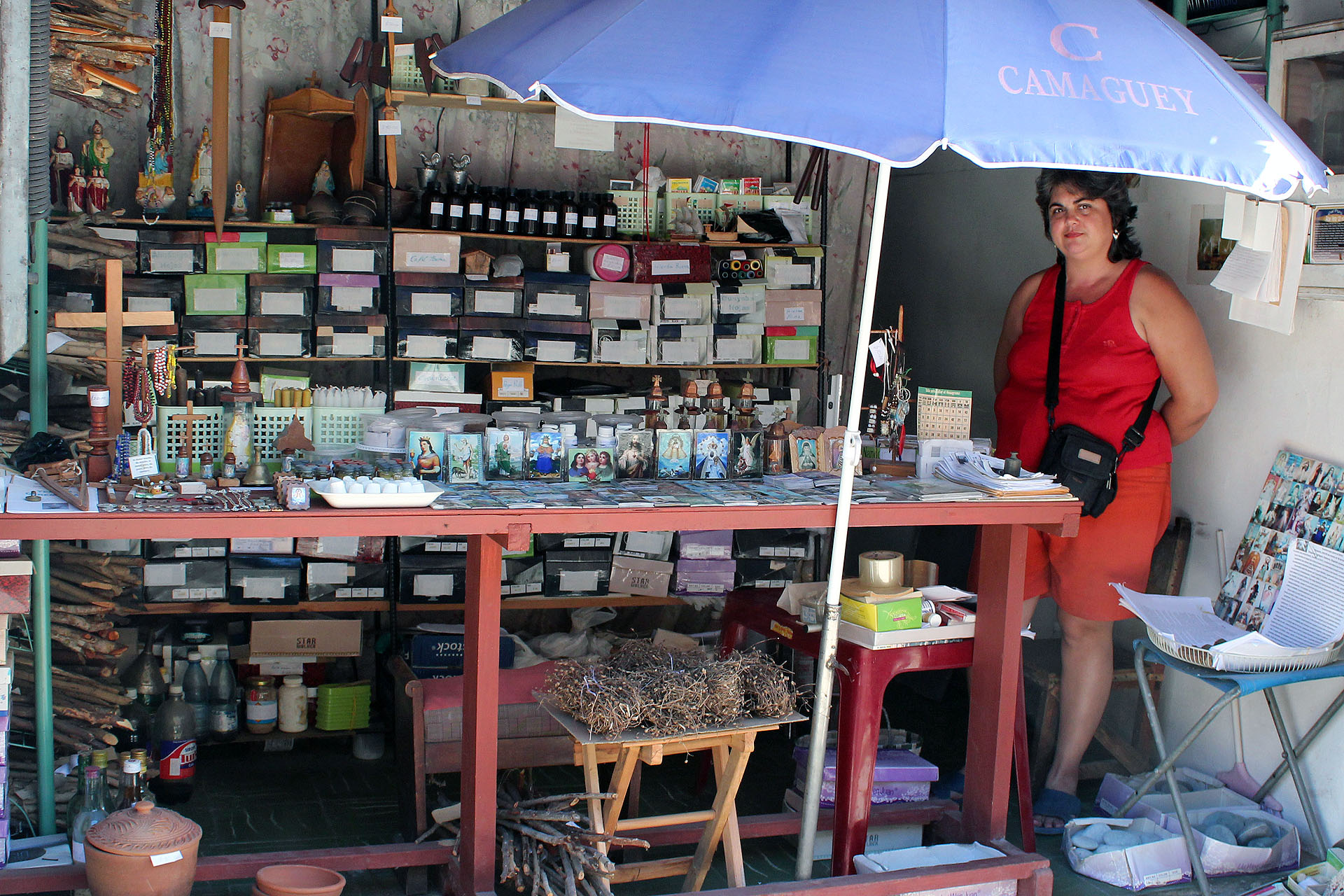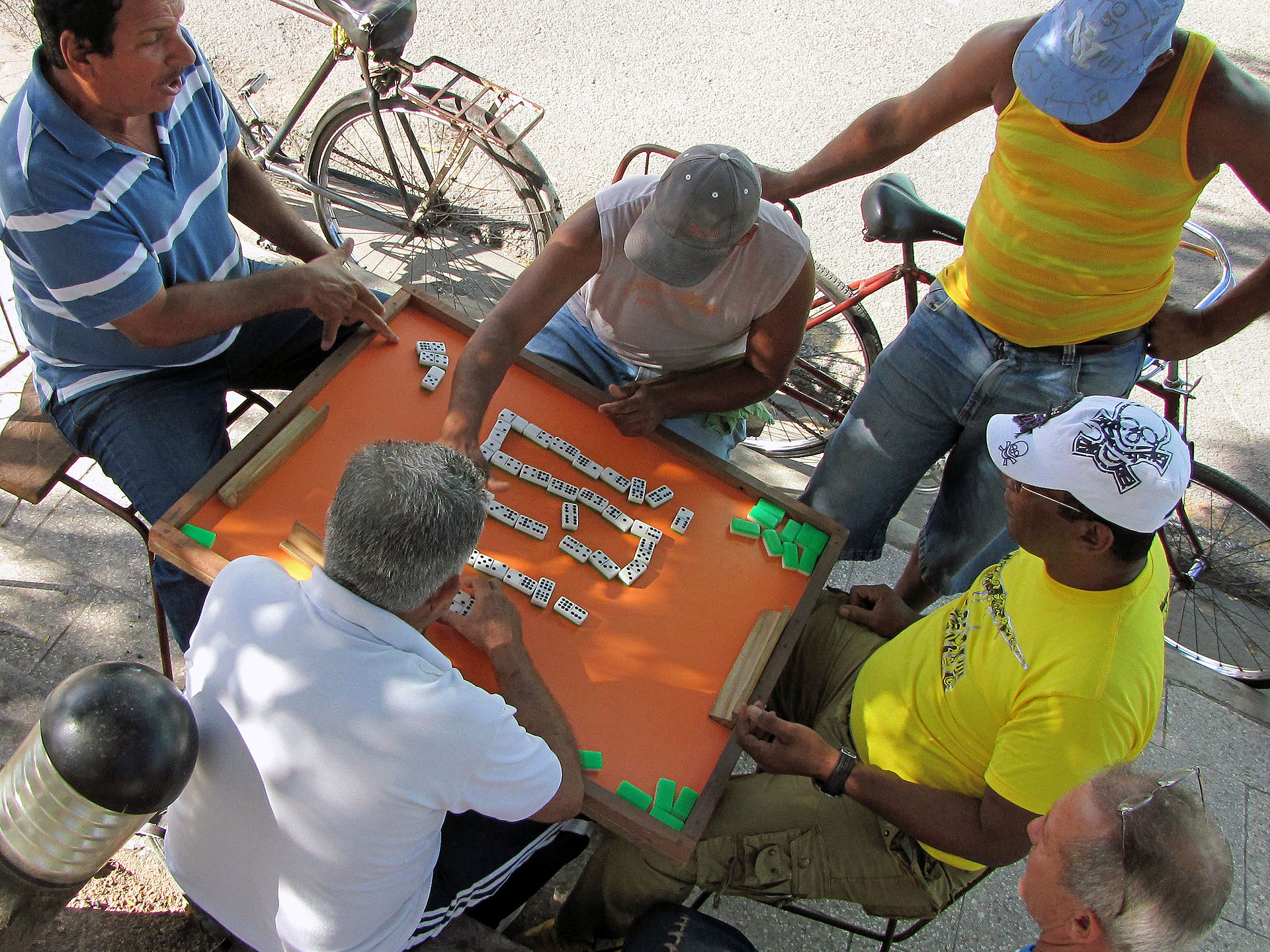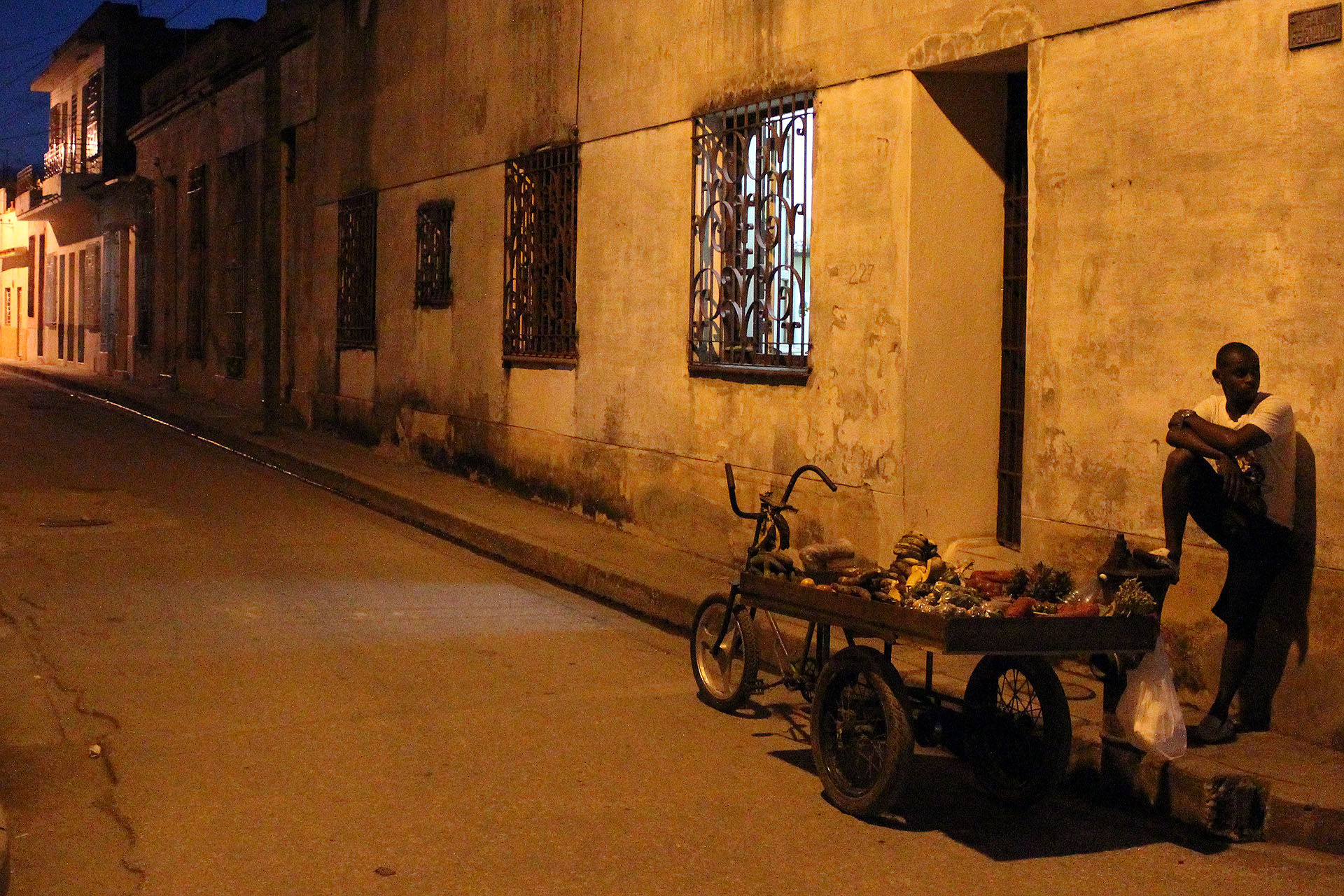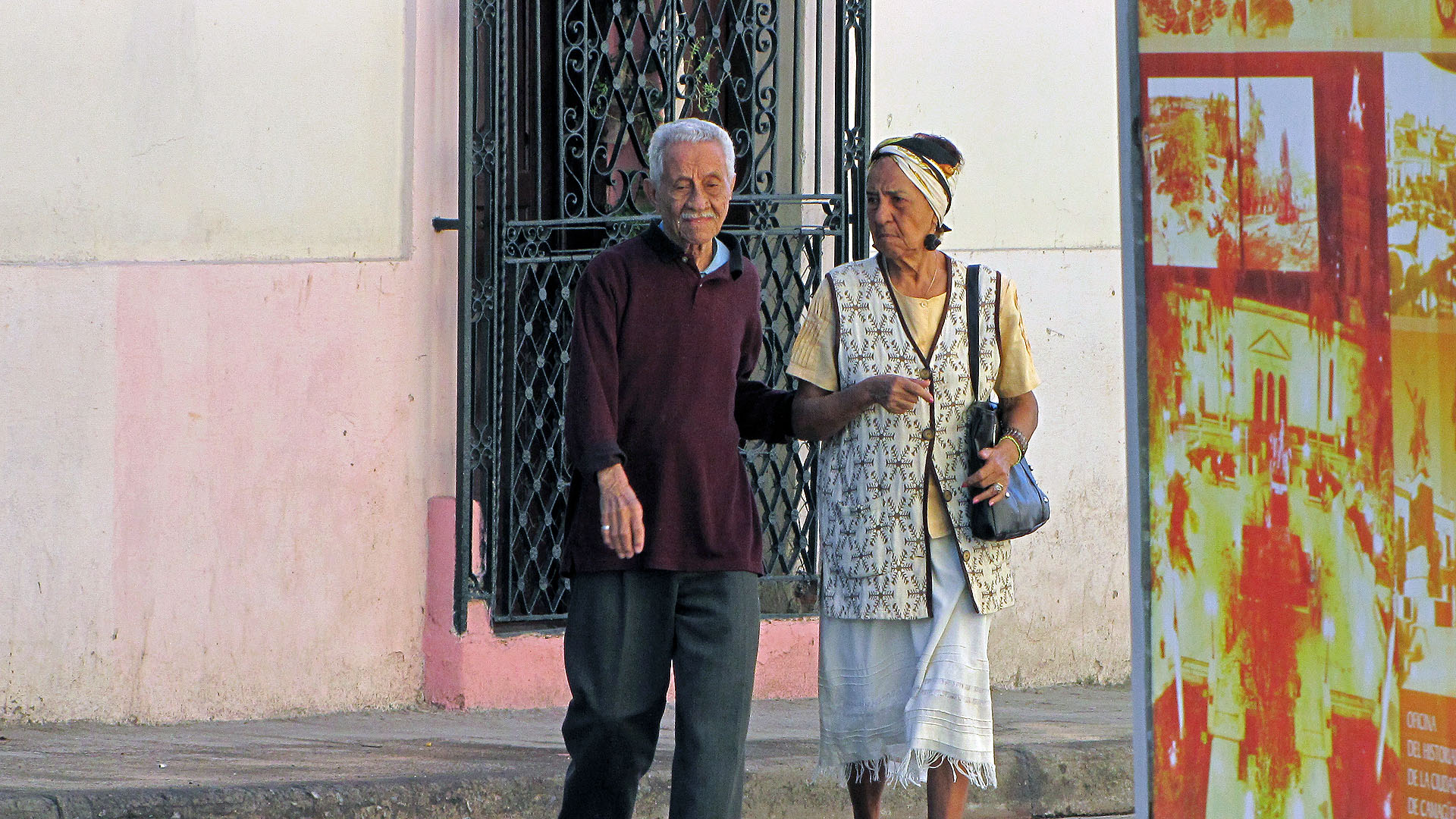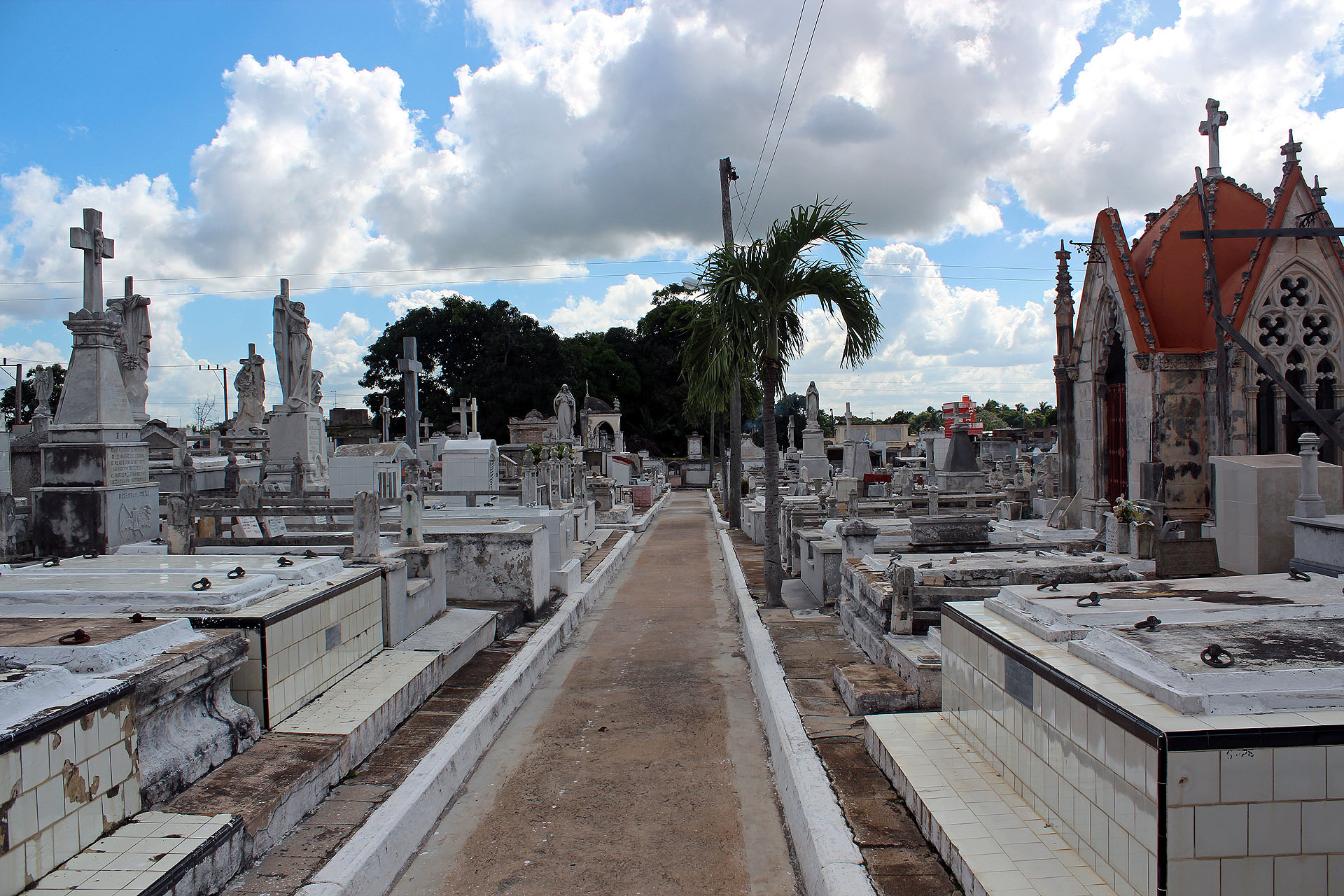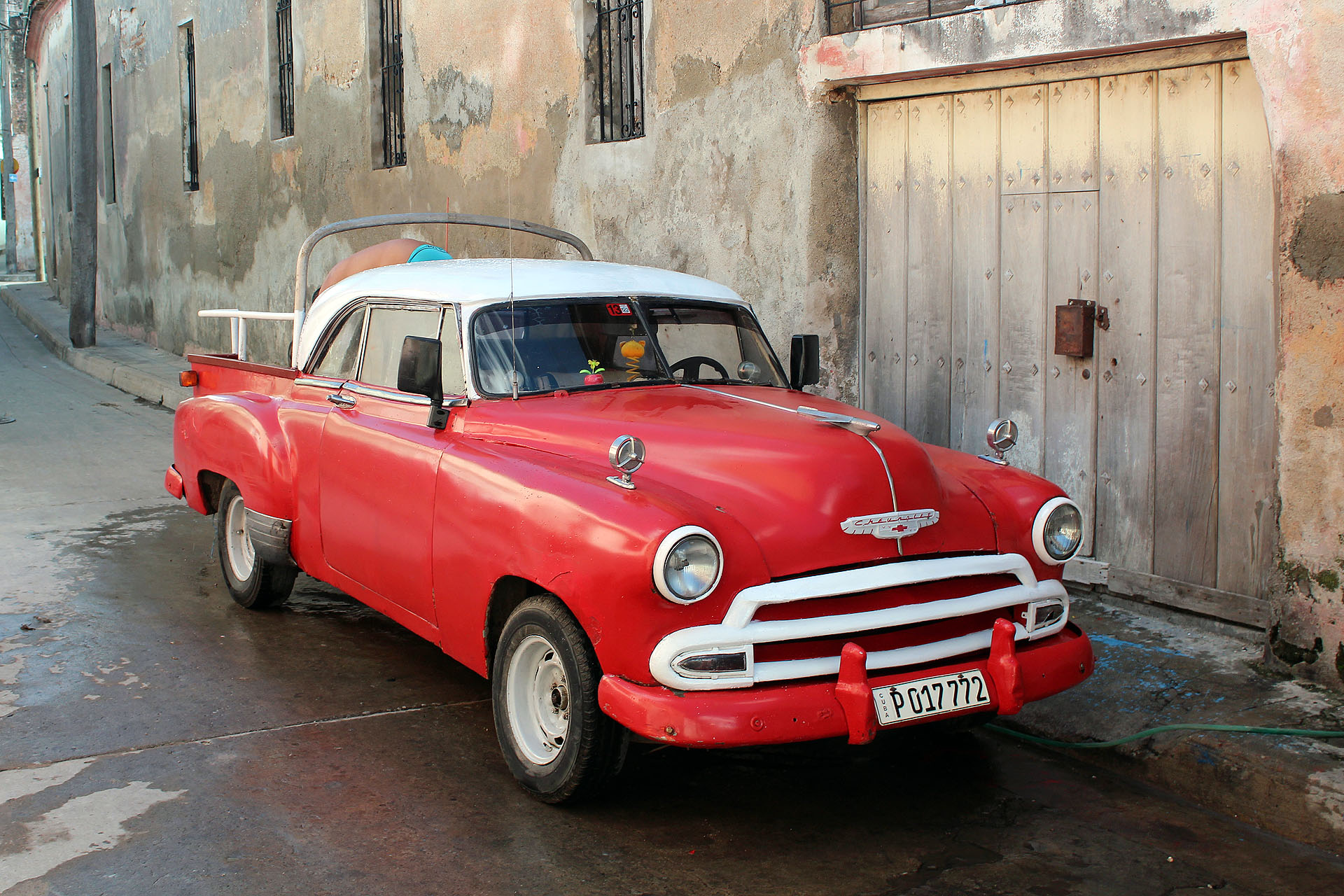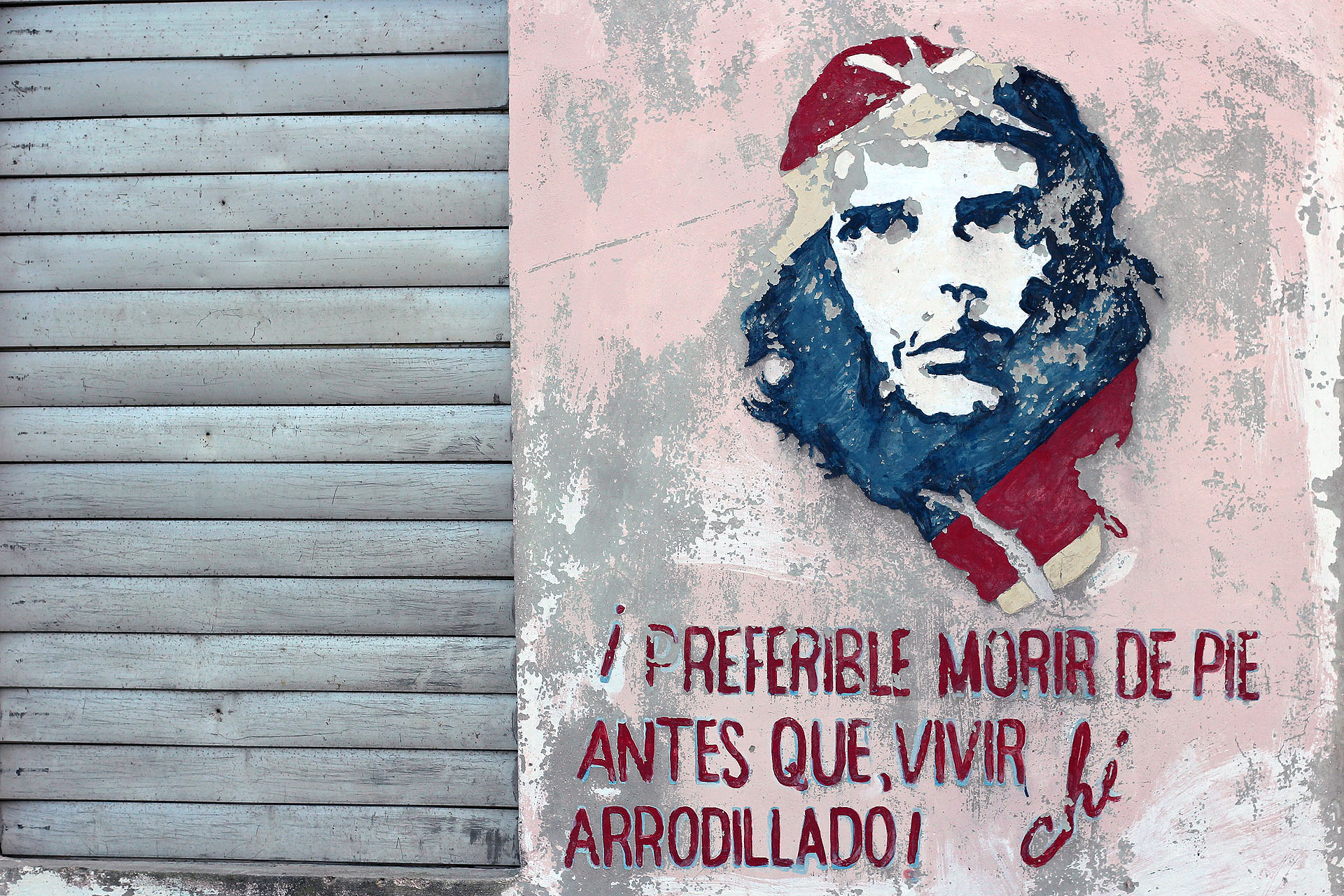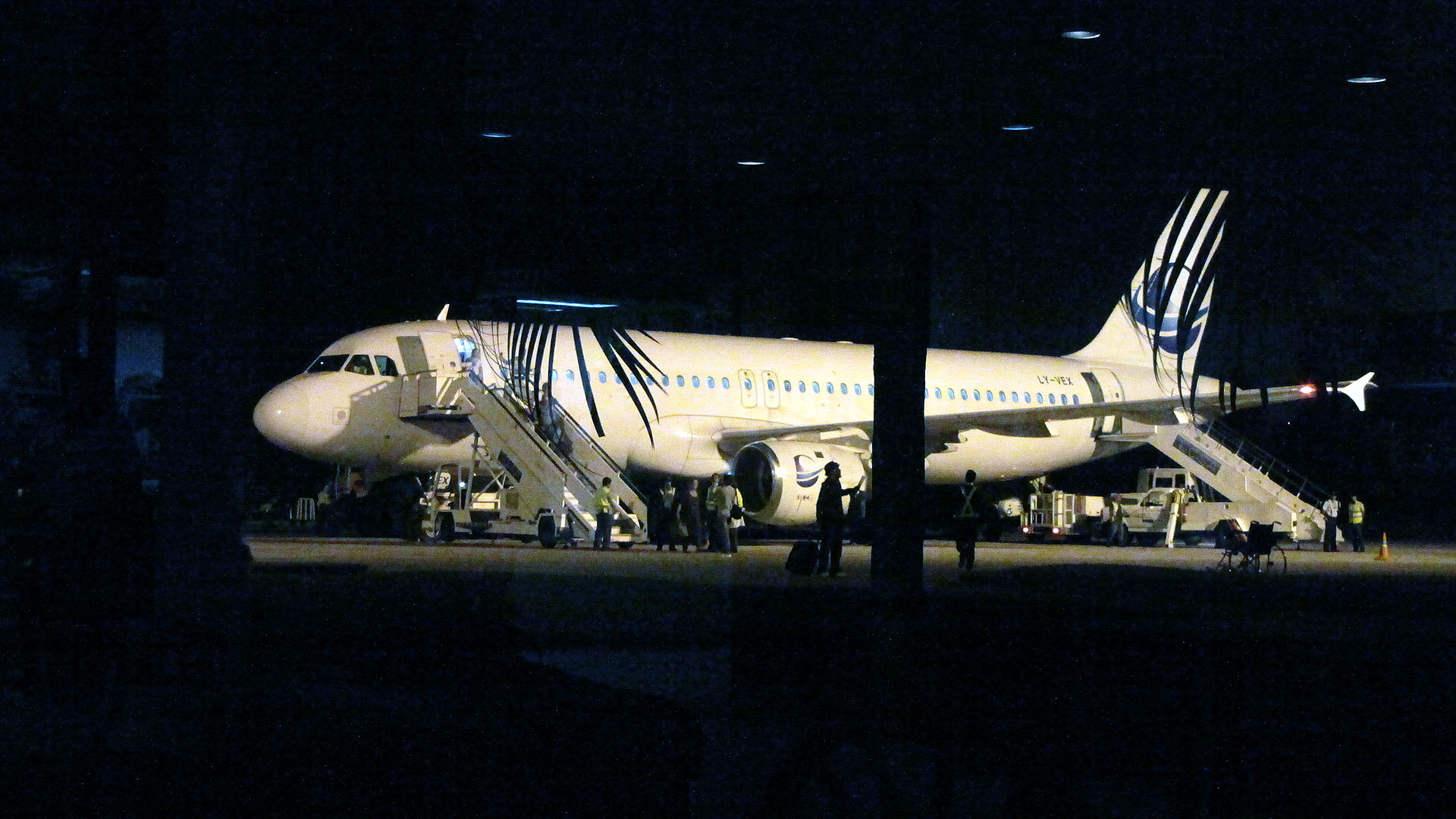Blog po polsku/in
Polish: http://ontario-nature-polish.blogspot.ca/2014/09/camaguey-cuba-w-hotelu-club-amigo.html
More photos from this trip: https://www.flickr.com/photos/jack_1962/sets/72157647698353620/
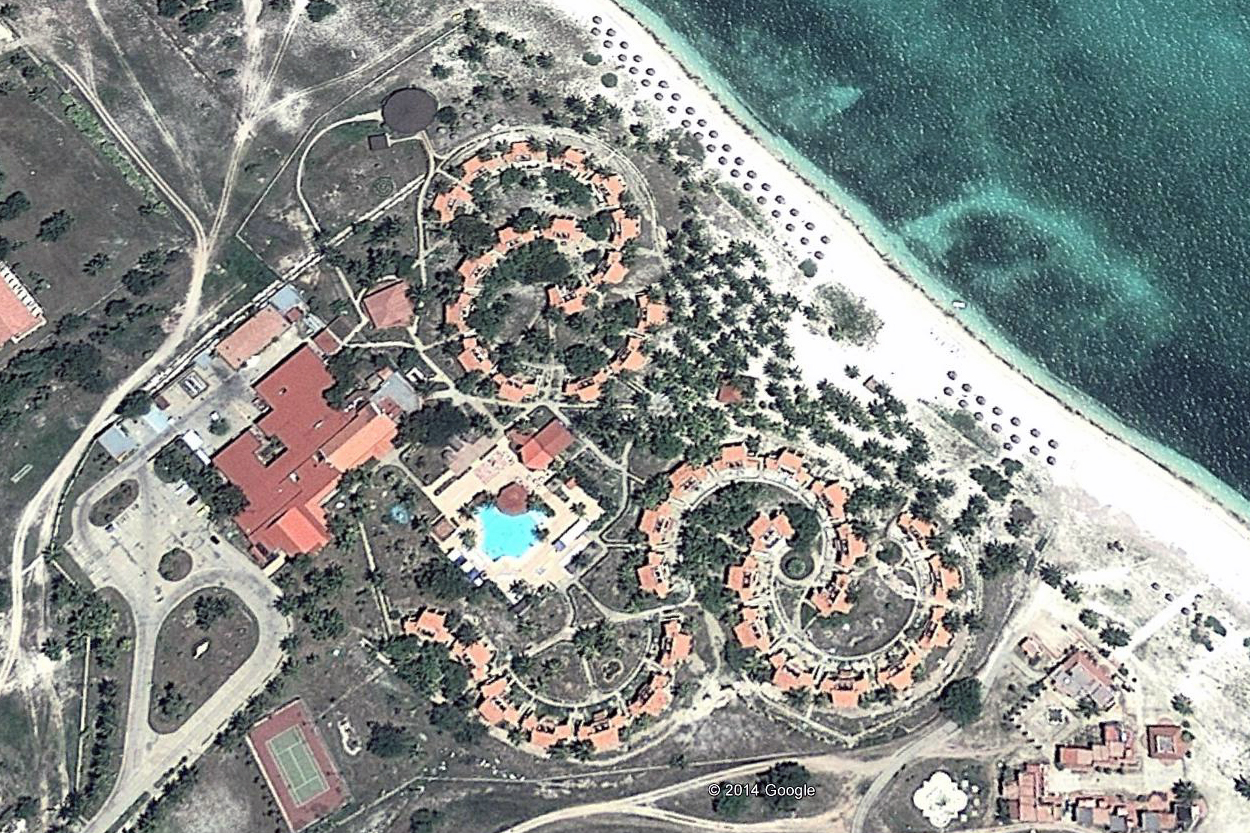 |
| A satellite map of our resort Club Amigo Caracol. |
Since we had never visited any of the resorts in Santa Lucia
— and had heard so much about them — the only question was which resort we should
go to. After several hours of browsing TripAdvisor’s reviews & forums and
exchanging a few emails with TA’s members, we decided to go to the Club Amigo
Caracol, which appeared to be very cosy, reasonably-priced and rated as the no.
1 resort in Santa Lucia.
Just a few weeks before our departure I had a client in my
office and we started talking about Cuba. I told her I was going to Cuba
shortly.
“Where are you going?” she asked.
“To Santa Lucia,” I said.
“Which hotel are you staying at?”
“The Amigo Caracol.”
She seemed quite stunned.
“Do you know this hotel?” I asked
her, thinking that perhaps she had had some bad experience while staying there.
“My Cuban boyfriend works there and
I will be going there in January of next year,” she said.
Wow, the world is a small place!
On the day of departure she met us at the airport and gave
us a gift for her boyfriend, which we of course delivered to him at the resort.
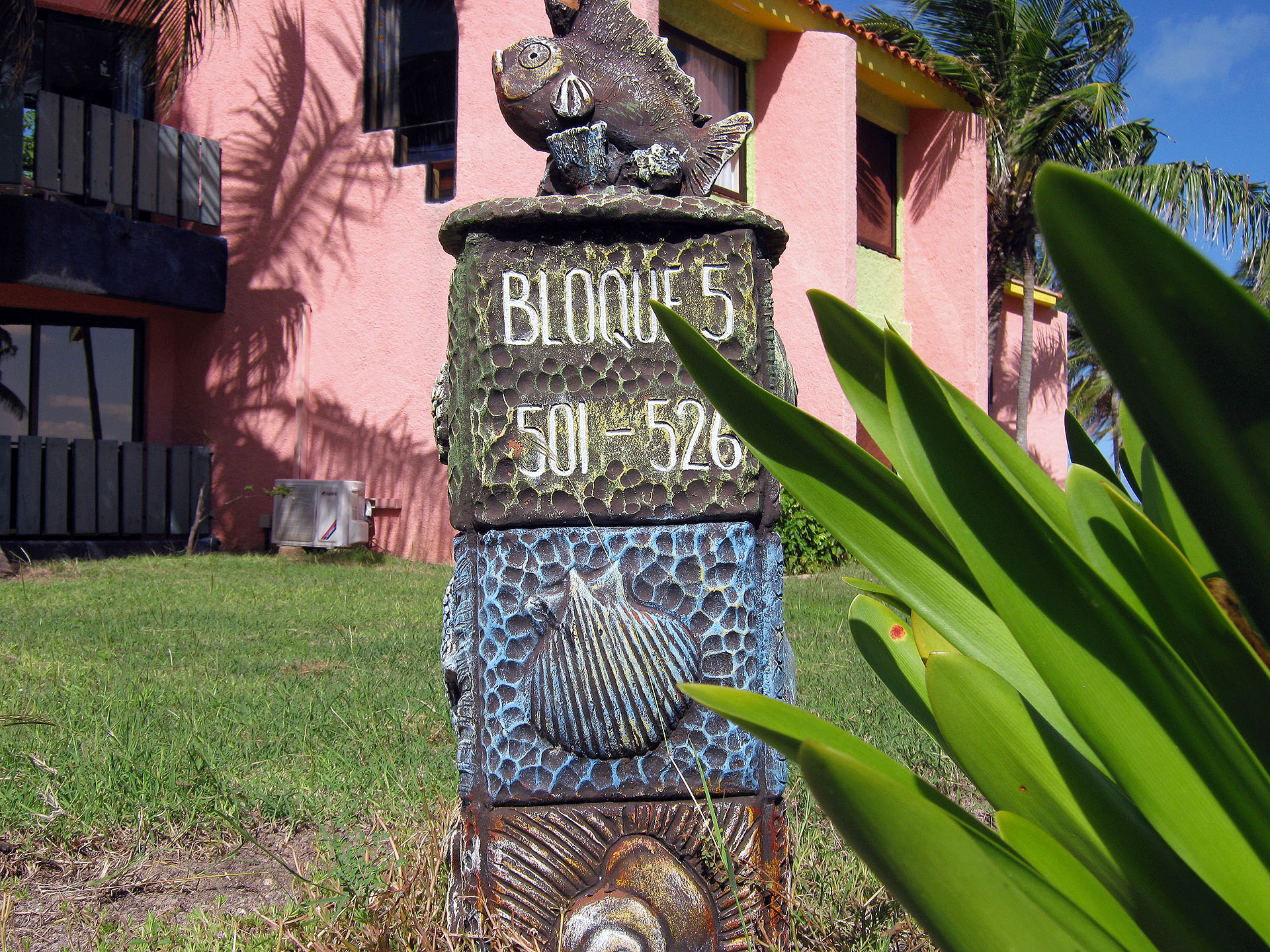 |
| Our room no. 510 in block "500" |
And thus on November 22, 2013 (incidentally, exactly on the
50th anniversary of President Kennedy’s assassination) we departed
from Toronto to spend the next two weeks in Cuba. The Cubana Airline flight no.
181 proceeded without problems (in spite of numerous warnings that it was a
very unsafe airline) and exactly after 3 hours and 15 minutes we landed in
Varadero, where some passengers disembarked, others got on the plane (which,
after landing at Camagüey, was flying back to Toronto) as well as a new Cuban
crew took over. At 6:00 pm the plane began to slowly move towards the take-off
position… only to stop and roll back to its prior position. Soon, I saw that all luggage was removed from
the plane (I even spotted my blue suitcase!). We had no idea what was going on;
some passengers thought that there was a mechanical problem with the plane and
soon we would be asked to leave the plane, but it turned out the Cuban crew
that left the plane could not find their luggage. So, after this one-hour delay
the plane took off and 40 minutes later landed at Camagüey.
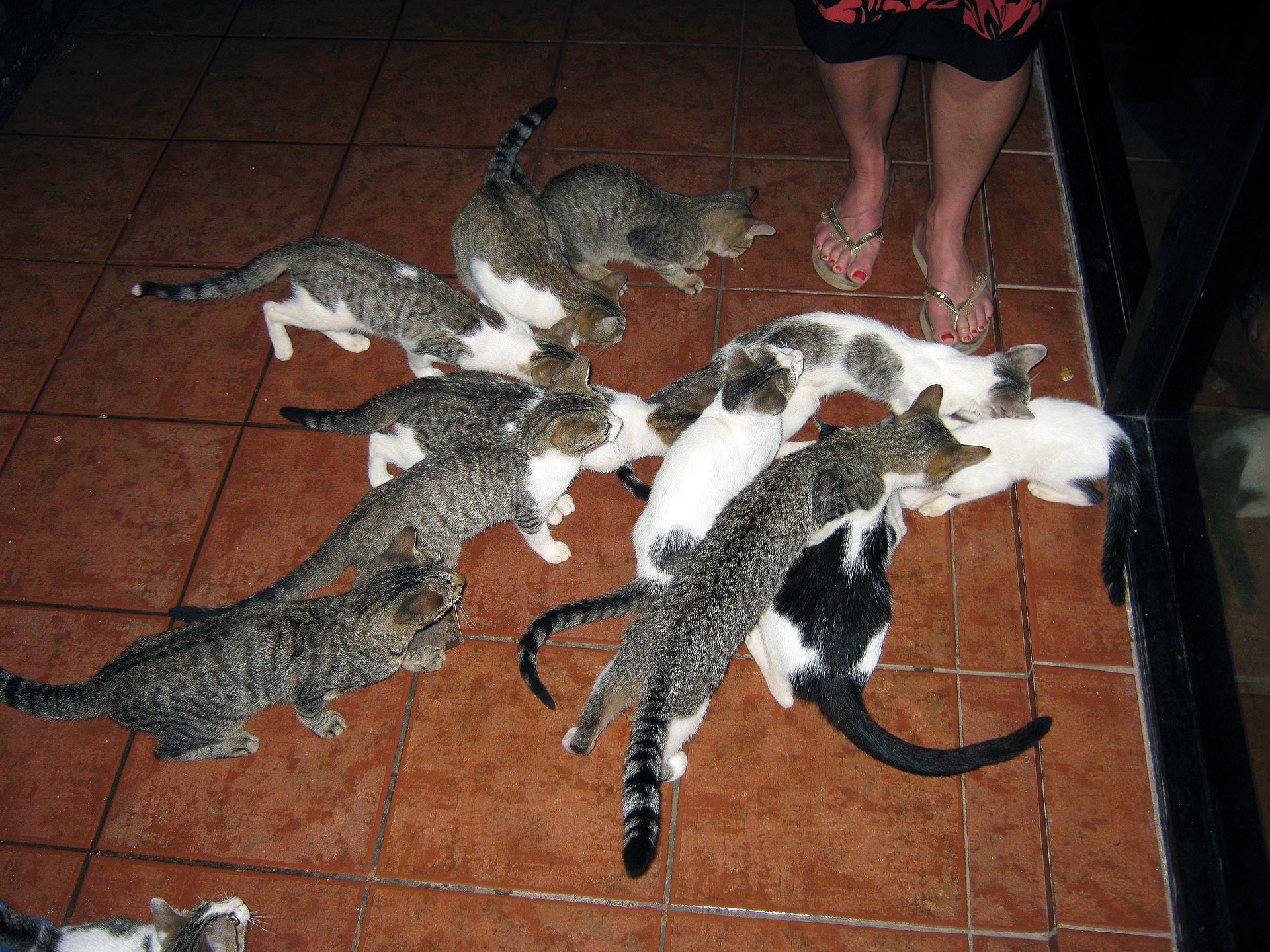 |
| There were at least 13 cats, patiently wanting in front of the restaurant |
After quickly and painlessly going through the immigration/customs,
we left the building and immediately a Hola Sun representative approached us,
holding a pad with a list of names — ours were luckily on the list, so he told
us which bus we should get on. In the meantime, I went to the money exchange
booth at the airport (just near the exit door-there was no line-up) and
exchanged $500, receiving about 460 pesos. There were Cubans selling beer (only
Cristal) for 2 pesos (or $2.00),
which was a little expensive (you can get one at stores for half the price).
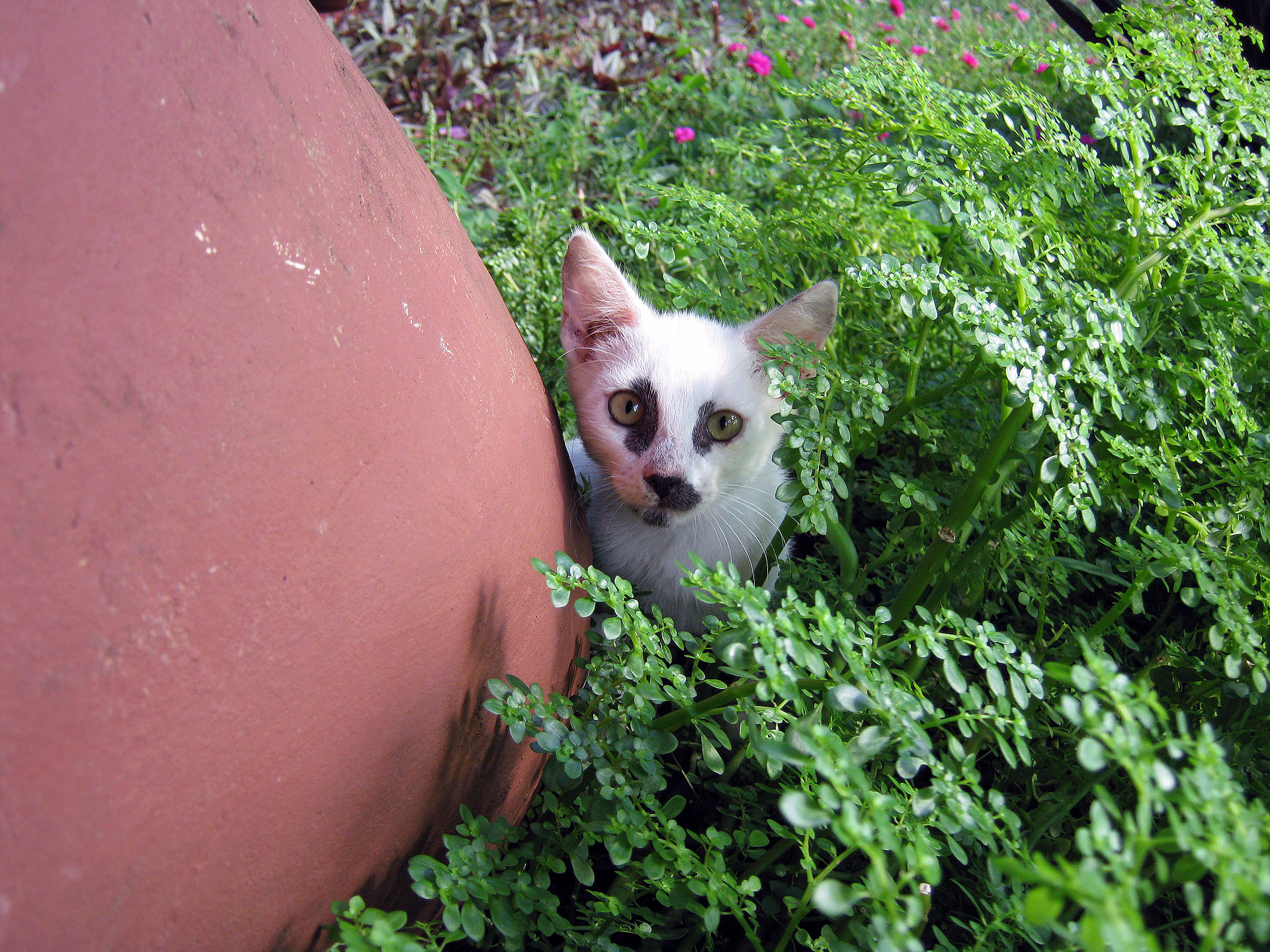 |
| My favorite cat |
The bus ride took 1.5 hour and once we arrived at the resort,
the hotel staff was waiting for us. Catherine ran to the reception in order to
get the best room and I was standing near the buss, collecting our pieces of
luggage. We quickly were assigned a room (no. 510), got the wrist bands and one
of the hotel employees brought our 5 pieces of luggage to our room, carrying
them up the stairs (yes, we tipped him I CUC per each piece of luggage). Although
it was quite late, we were still able to have dinner, which was great, as most
of us were quite hungry. While inside the restaurant, we saw plenty of embraces
and hugs among tourists and hotel staff/servers — indeed, some people had been
coming to the Caracol regularly for many years. We met a very interesting,
88-year old gentleman (a machine gunner in the Second World War, he took part
in the June 6, 1944 Normandy landing), who also had had a triple bypass
surgery, an artificial knee and lung problems due to his work with asbestos. In
spite of his problems, he seemed to be in a great shape and most returning
tourists knew him quite well.
“How often do you come to Cuba?” I
asked him.
“I only sometimes go back to CANADA
for vacation — otherwise I stay in Cuba,” he replied.
We later encountered him zipping around on a rental scooter
in the nearby village. ‘Nuff said!
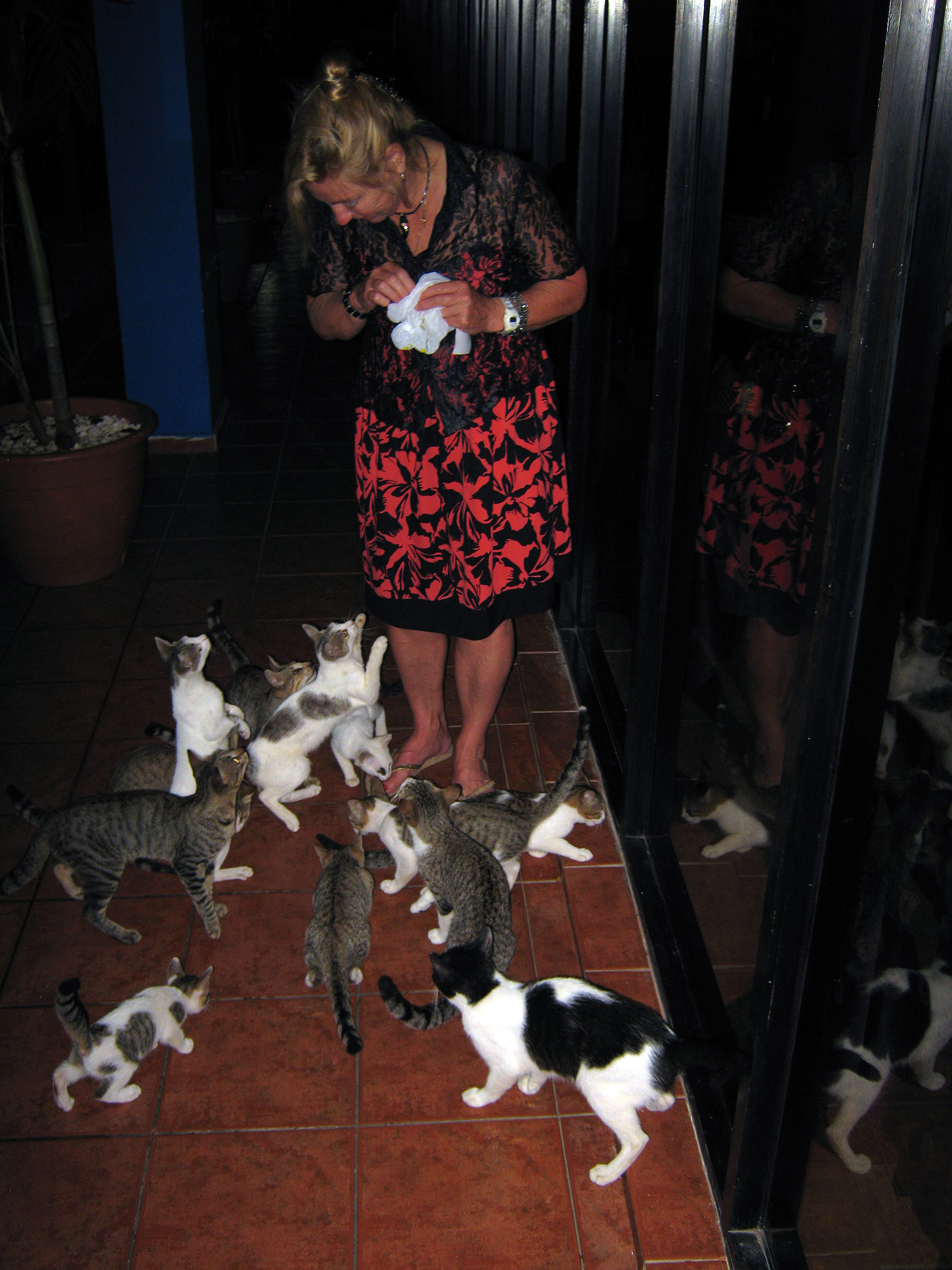 |
| Cats befriended Catherine in no time! |
There were 5 semi-circular sections (blocks) and we stayed
in the ‘500’ block (as per TripAdvisor’s advice), which offered an ocean-view
and sheltered us from the noise coming from the entertainment area. Besides,
certain sections/rooms (the better ones) were only available to those tourists
who bought Hola Sun packages. The room, on the upper floor, was very nice. It
consisted of a ‘living room’, with a balcony facing the ocean (with two beach
chairs), a sofa, armchair, small fridge and a coffee table. It was possible to
slide the balcony windows wide open as well as open the other window, which
faced the ‘400’ block. The bedroom had two double beds, a TV set, telephone,
safe, closet and a very big, sliding window. Remote-controlled air conditioner
worked very well. Since it was quite windy most of the time, we used air
conditioning very sparingly, preferring to sleep with windows open. Because of
the wind, there were no mosquitoes, but once it became calmer, we did see
several mosquitoes in our room. There were also tiny ants (?), but almost
invisible — yet when I left my empty cup, with traces of coke & rum, in a
little while I saw plenty of those miniature insects swarming all over the cup.
Yet they did not bother me — I would rather deal with them than some toxic
insecticide.
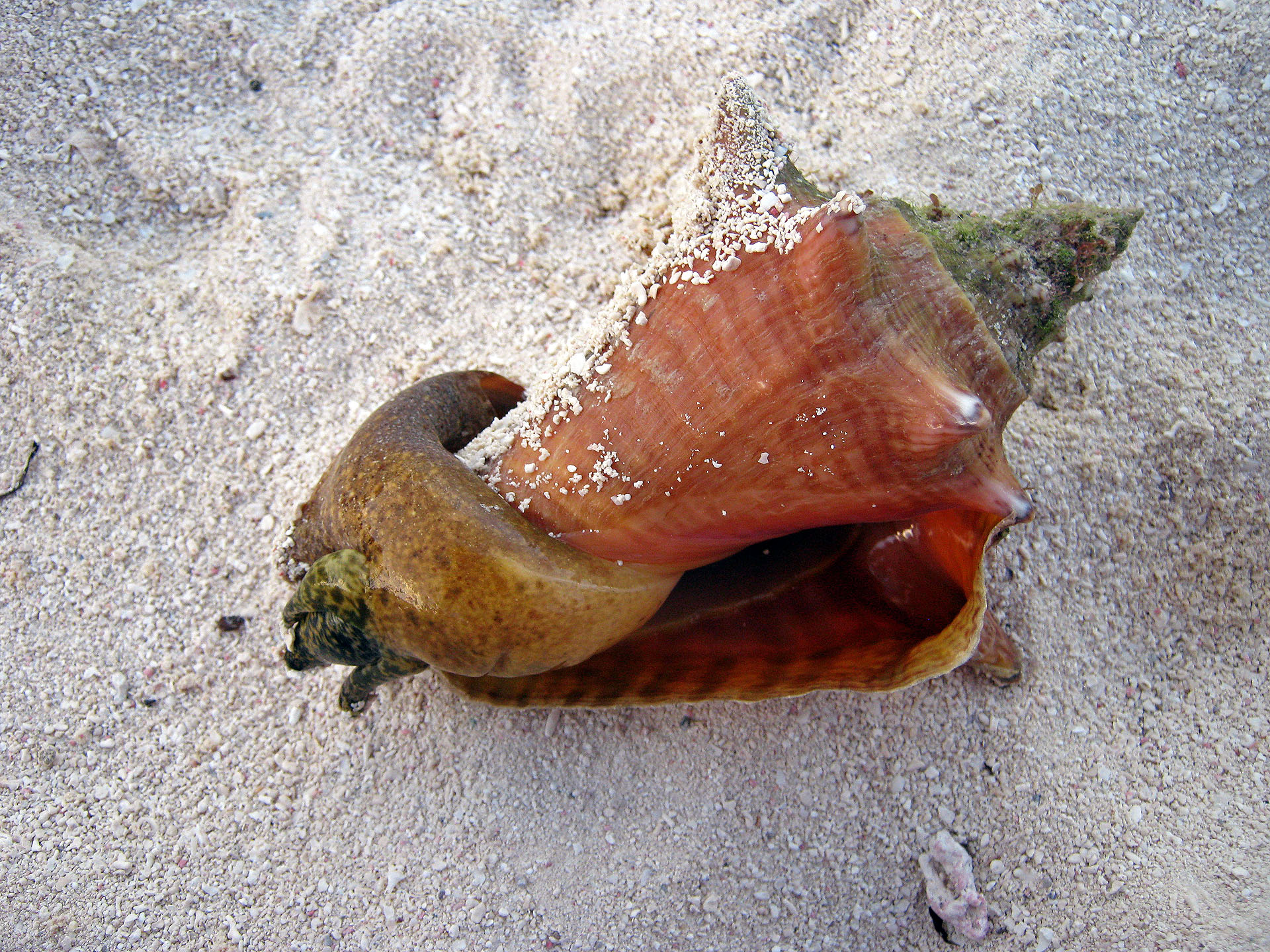 |
| On the beach |
The bathroom was spacious, with a bathtub and a hair dryer.
The shower head was not working very well, but enough to take a shower. There
was always hot water. There seemed
to be solar panels on each unit's roof .The fridge worked, but just
barely kept beverages cool and did not have a freezer. There were about 30 TV
channels, including CTV from Toronto; since we did not have/watch TV in Canada,
we only watched it for a few minutes at a time, mainly to check what the
weather was like and if there were any new weird developments or antics
concerning the intriguing mayor of Toronto, Robert Ford. Except for Nelson
Mandela’s death (at whose funeral Barack Obama and Raul Castro shook hand, yet this
symbolic act did not result in any breakthrough in the American-Cuban
relations), it was a very uneventful period of time in terms of world news.
Our room’s door was opened/closed with a magnetic card and
we got a second one from the reception. Exactly one week later the cards ceased
to work, even though we came for 2 weeks — we were told cards were programmed
for 1 week, so we had to go to the reception to have them re-programmed.
It rained a few times (usually very briefly), once we left
the window and balcony door open and some water got on our floor which became
VERY SLIPPERY! Also the tiles in the bathroom, when wet, became SLIPPERY; we
often spread towels on the floor to prevent tripping. The maid (Marta) did a
very good job cleaning our room and every day we left her 1 peso; in addition,
Catherine gave her some chic clothes that her fashion conscious daughter no
longer wore and Marta passed them on to her daughter who was about celebrate
her 15th birthday….a big deal in Latin American countries.
 |
| Tasty! |
The resort was pleasant and everything was nearby. The beach
was sandy, its width kept changing by a few meters due to tides — on the last
night of our stay it was very windy and when we went to the beach in the
morning, we could see that overnight the waves had flooded at least 2/3 of the
beach, leaving plenty of seaweeds all over. A tractor raked seaweeds off the
beach on a daily basis. Usually we would come to the beach at 2:00 pm and
stayed till 5:00 pm. It was quite windy most of the time, yet the long reef,
located several km from the shore, made a very effective protective barrier,
blocking the waves and thus it was possible to swim almost every day, as the
waves were not a problem at all. There were about 50 kite surfers (mainly from
Quebec) and they had a blast! Some were surfing (too) close to the shore,
others were barely visible, choosing to surf near the reef. The water was quite
shallow, even many meters from the shore. Unfortunately, it was impossible to
see anything noteworthy under the water while snorkeling off the beach and
that was why we decided to take the snorkeling tour.
When the weather was really nice (sunny & calm), on a
few occasions we had difficulties finding empty chairs on the beach and I ended
up lying on the sand, which was not a big deal. On the first day after arrival
we got two big towels from the hotel and used them on the beach all the time.
We also brought two towels from Canada and had several requests for them from
locals when we were leaving.
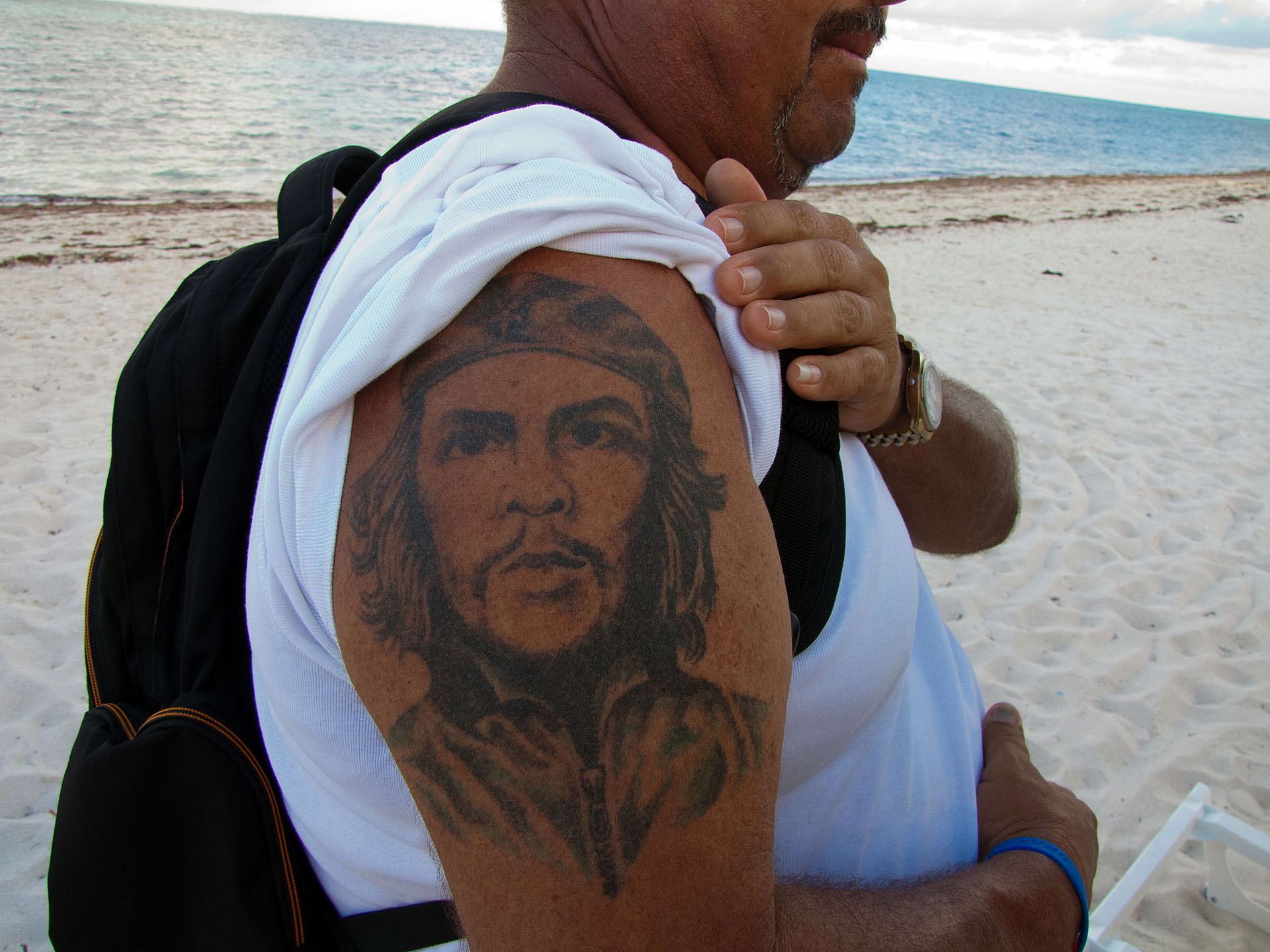 |
| Enrique with a very unique tattoo |
There were a number of Cubans regularly walking along the
beach and striking up conversations with tourists, trying to sell carvings,
necklaces, hats, shells, starfish or offer lobster dinners, buggy rides or even
find good taxi drivers. One of them, George (his name had been mentioned in
many reviews on TA) was quite a nice, nonintrusive fellow and we spent some
time talking to him.
“Hi George, Gina sends you
greetings from Canada,” I shouted to him when I saw him the first time.
He was a little surprised to hear that, but then I told him
that I had contacted Gina through TripAdvisor and she had mentioned his name,
asking me to say ‘hi’ from her.
Yet we did not use any of his services as we were not really
interested in a lobster dinner. Catherine bought a very original necklace, a
stylish crab claw, from an older beach seller called Enrique, sporting an
impressive tattoo of Che Guevara, which I immediately photographed. To be
generous, Catherine also bought an inexpensive black volcanic rock bracelet
which she thought perhaps his daughter had sent from a Miami dollar store where
she resided. Lo and behold, one of the waiters complimented Catherine
extensively on the bracelet and actually went and bought one for himself. In
the meantime Catherine bought another one and presented it to the waiter who
happily accepted it. I wanted to buy a very creative carving that another
vendor was offering, but I never saw him again. There were catamarans and pedal
boats on the beach, but we never used them.
Gardeners made excellent job keeping the grounds clean;
every day they raked the surroundings — and every day we could see plenty of
holes, especially along the sidewalks. In Canada, I would assume that chipmunks
were making those holes; in Cuba, it was purplish and orange crabs, known as
Halloween Crabs, yet they were very timid and it took some time before I
actually saw them — apparently they must have not only seen us approaching
(they did have big eyes!), but also detected our footsteps’ vibrations and
quickly retreated to their burrows.
Several times we asked the gardener to bring us coconuts for
1 peso — he peeled them with a machete and made an opening so that we could
drink the coconut water and then eat the delicious pulp. Catherine and a
neighbour (Larisa, living in Toronto, originally from Russia) soon had a daily
8:00 am o’clock date with this man outside our block. At one point he also
supplied them with local honey, poured into a water bottle.
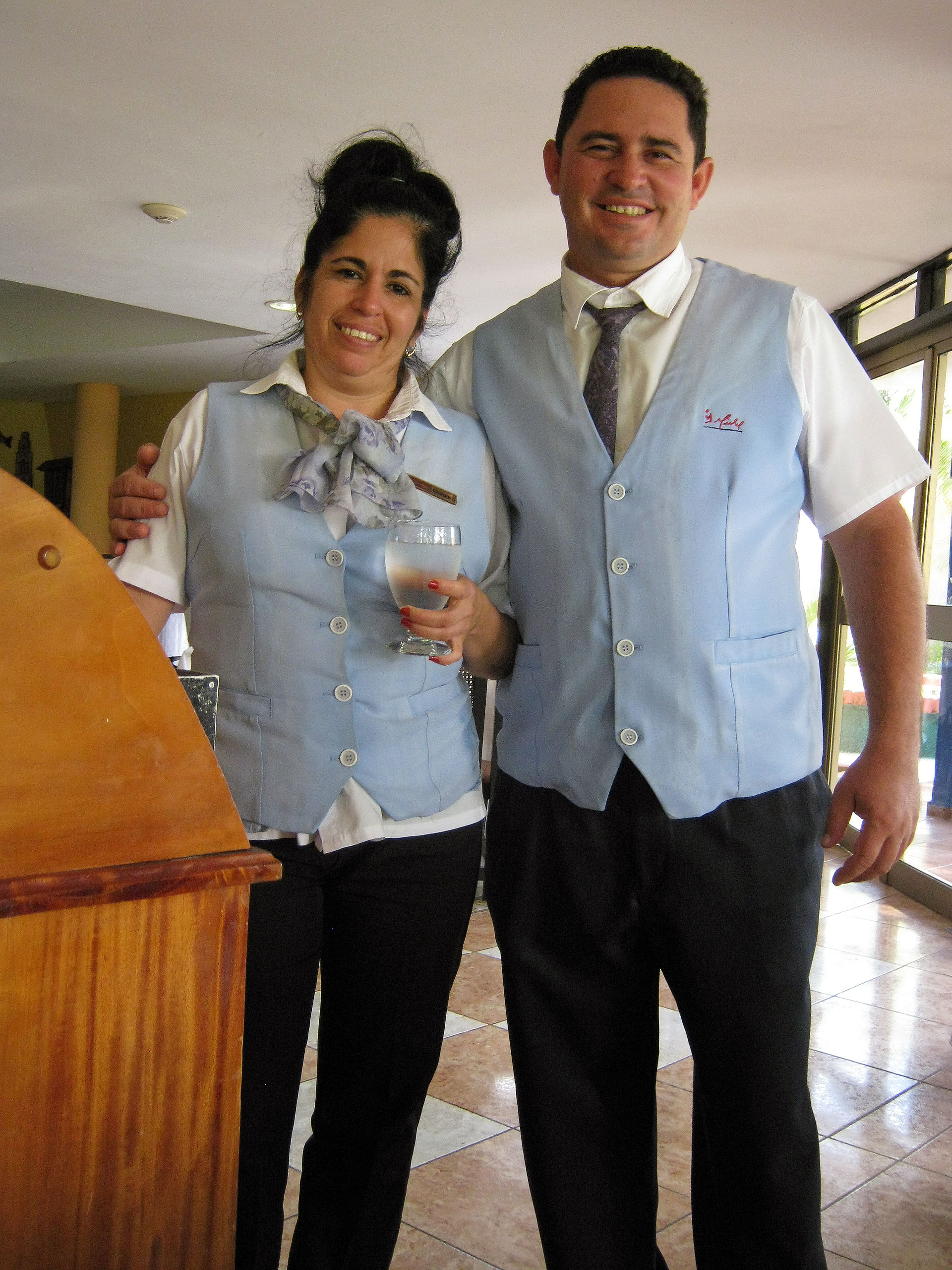 |
| Our servers |
Next to the dining room there was a shop (tienda) where rum, coke, beer, postcards,
cigarettes/cigars and various items could be purchased. Unfortunately, the
store did not have my favourite Bucanero
beer and only ‘generic’ cola, yet the gas station, some 1.3 km north of the
resort, carried both (one peso per a can of beer and 2.70 peso for a 2 liter
Coca Cola, ‘hecho en Mexico’, which
had a somehow different flavour from that sold in Canada). The postcard
selection at the store was OK, but they were expensive (one peso each, whereas
the same postcards in Camagüey or at the airport cost from 0.35 to 0.45 peso).
Near the gas station (adjacent a tall communication tower) was a post office. Twice
we mailed a bunch of postcards to Canada, Europe and the USA. When five months
later none arrived at its destination, I assumed they had just disappeared, but
in May, 2014, they finally started reaching their recipients; Catherine’s
daughter, who lives in the USA, was the final recipient some time in July,
2014. Just before the gas station there was a striking, Italian-style building.
It was the “Clinica Internacional de
Santa Lucia”. There was a guard sitting in front who let us wander around
this building. From what we could understand, it had been built by Italians and
it was supposed to be a wellness retreat/clinic — there were plenty of signs everywhere
(restaurant, consultation room, spa, elevator), but the clinic had never
actually opened and the building was being remodelled into a hotel.
During the whole stay, we had no more than 5 ‘free’ drinks
at hotel bars — well, we did not spend any time at the bars anyway — in
general, I did not like such drinks, they had too much sugar, additives and God
knows what else and I did not feel good after having them. Besides, at that
point, we were on a bit of a health kick, eating and drinking coconut water. We just purchased a few bottles of
rum/liqueurs/juices/coke in the store and made our own drinks, but since I was
not too crazy about such ‘hard’ liquors, I much preferred having a few glasses
of red wine at the restaurant. Yet for those who do want to get drinks at the
bars — do bring large mugs or big, sturdy glasses. The bar plastic cups were
small and flimsy.
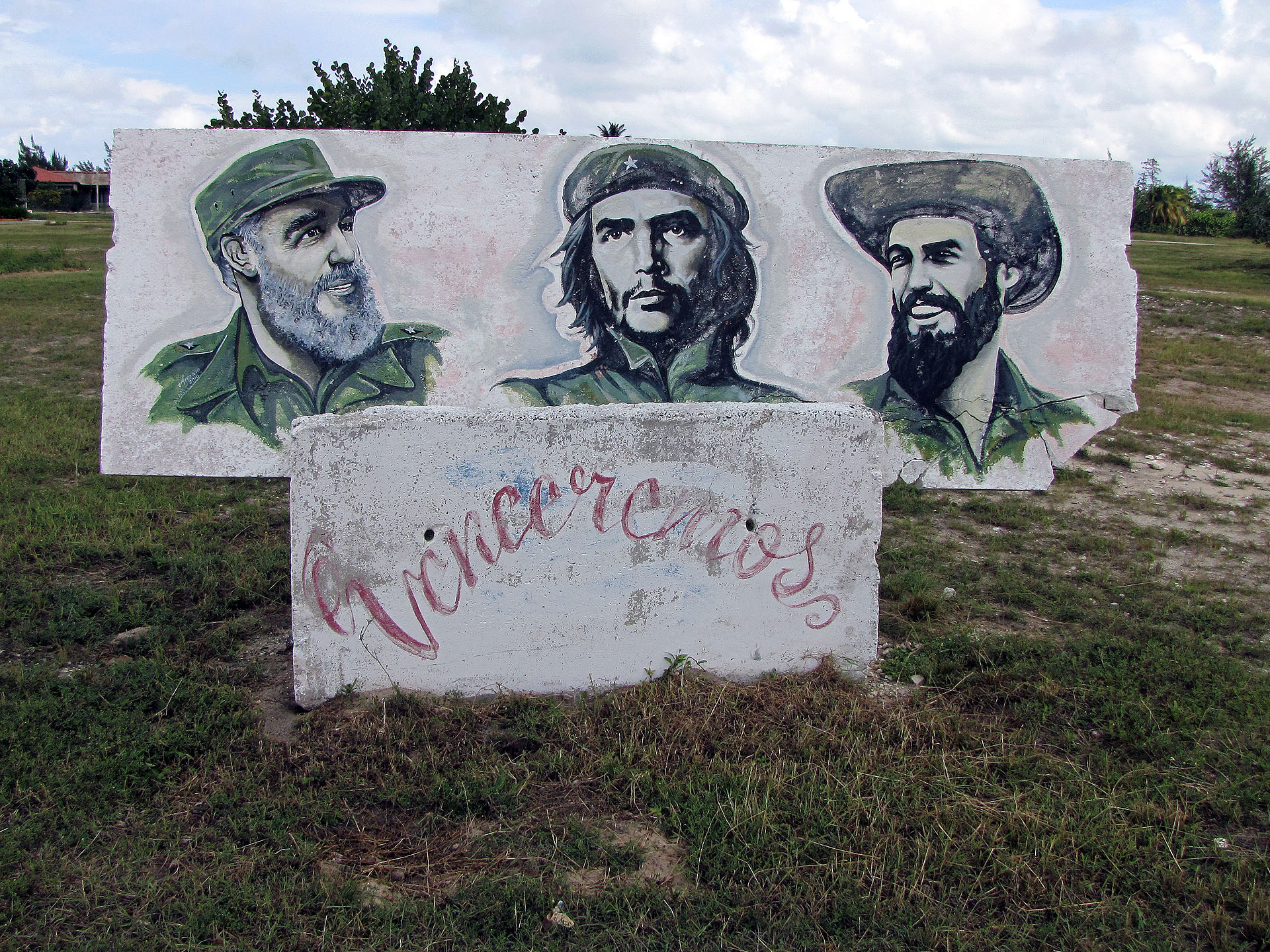 |
| Near the gas station |
We also went to the scuba diving center and I spoke to a
Canadian (most likely of Polish origin) scuba diver. He said that if you did
not have a certificate (Padi), it was
possible to take a crash course there for about 75 pesos and then go scuba
diving, making dives, I believe, up to 10 meters. Since I was not that
interested in scuba diving and would not like to invest time & money on
diving courses & equipment, perhaps it would be a good way to try scuba
diving. Well, I had completed an extensive scuba diving course in 1978/1979 in
a club called “Wanda” and later participated in a three-week long scuba diving camp
on Szeroki Ostrów Island on Lake Śniardwy, but had not been really enthralled
by this activity at that time: the equipment was rudimentary, the water was
cold and muddy and it was difficult to see anything of interest anyway.
Although it was possible to exchange money at the resort
(and pay a small surcharge), there was a Cadeca
office at the Centro Commercial Santa
Lucia, just north of the Caracol. They wanted to see my passport — I showed
a colour photocopy and had no problems. We went there twice and I never had to
line up. There were a few other stores as well, offering beer, cola, cookies,
candies, etc.
On the second night I went to the beach party as well as
spent no more than 15 minutes watching a show (it was a rather pleasant
rendition of John Lennon’s “Imagine”),
but otherwise we were not interested in any performances, animation or bingo.
Some shows were quite noisy since we could hear them in our room. On the first
Saturday night after arrival we checked out the White Party on the beach in
front of the Commercial Centre next door. There were lights, loud music, lots
of young nationals dressed in white, occasionally dancing, and some craft
vendors.
Everybody was raving about David the masseur and some people
had a massage every day. We went to the gym, where he had his room. We briefly
talked to him and Catherine eventually had one massage. She liked it, yet said
that her outstanding Chinese masseur in Toronto was better for deep tissue
which she requested. On the other hand, Dave told her that he did not want to
exert too much pressure on her as not to make her too sore.
 |
| International Clinic, never opened |
All the meals were served in one building, as well as there
was one à la carte restaurant. It was
possible to get, in addition to drinks, French fries and burgers in the beach
bar from 10:00 am to 5:00 pm which was a small, open air wooden edifice behind
block 400. We tried it once, requesting the acclaimed fish ‘n’ chips.
Unfortunately, a new cook had taken over and this item was no longer
available... or so the Hola Sun guide Jose told us when we ran into him there.
Breakfast was served from 7:30 to 9:30 am. I always had an
omelette or three eggs, made to order by the cook, coffee, juice, yogurt,
bread/buns with butter & cheese and I loved it! In the morning we also
brought empty plastic bottles and asked servers to fill them with water.
Most of the time we skipped lunch, but when we did have it,
it was very tasty. When you eat a large breakfast, it seems you can easily skip
the buffet, knowing the beach bar is an option.
 |
| Bar near the pool |
Dinner was served from 6:30 to 9:30 pm. There was always
something scrumptious to pick: beef, tasty pork, tender ribs, chicken,
delicious shrimps, cooked-to-order pasta/spaghetti, salads, fish… the waiter
brought us red wine (average+) and cold beer. I found the vegetable salads
rather disappointing and bland, there was no salad dressing (except for olive,
vinegar and garlic) and I hardly ever had any (not that I really wanted to have
salad anyway!). Desserts were very good, especially excellent ice cream. The
servers were very pleasant, promptly bringing beer, wine and other beverages,
never tried to sell us anything (as some had attempted to do in other resorts).
Now and then we were able to chat a little about their private life &
families and always left tips of 1 or 2 pesos.
We counted up to 13 cats in front of the dining room,
patiently waiting for tourists to give them food. Some were tame and liked
being petted, others did were too timid to be touched. Once they realized we
had food for them, all of them followed us religiously. Apparently the felines
also kept the vermin out of the hotel property — we did not see any pests. We
were asked by the head waiter to feed the cats away from the main steps leading
into the dining room, so like the Pied Piper of Caracol, we led them away from
their perches to the less busy end of the sidewalk.
As I mentioned before, we were entitled to one à la
carte dinner (but if you want
more, it was probably easily doable) at a separate open air restaurant close to
the beach and it had to be reserved in advance. We needed to book it with
Jennifer, whose usually empty desk was beside the lobby; tracking her down was
challenging, but with little persistency achievable. There were two sittings,
at 7:00 pm and 8:15 pm. We had two such feasts and both consisted of Cuban
cuisine (pork, salad, flan, beef, Spanish red wine). During the first one there
were very few people in the restaurant and it was a very windy evening. We
befriended a very nice couple from Elora, Ontario, who were sitting at the
adjacent table; soon we found out that they were quite familiar with some of
the places we had recently canoed & camped at Killarney Park’s Carlyle Lake.
Our second meal was a little bit too salty. During the two meals the server was
very attentive and courteous. In general, we enjoyed both dinners very much as
it was open air.
There were about 20 bikes for rent; the first hour was free,
then 1 peso per hour (although we were never asked to pay anything extra). Some
bikes were not in top shape (flat tires, loose mud guards, impossible to adjust
seats) and needed basic repairs & routine maintenance, but we always
managed to get good ones and overall I found them quite comfortable to ride.
Almost every day we spent from 1 to 3 hours bike riding, either to the north,
to the village of Tararaco, or to the south, towards Camagüey. There was a gas
station (plus a store) just over 1 km south of the hotel, adjacent to a very
high communication tower, where it was possible to pump air. Francesca was
responsible for pedal bike (and scooter) rentals and she could be usually found
at her desk just outside the resort store. I never rented a scooter, but stroke
up a conversation with a Canadian tourist; looking at the themes on his t-shirt,
I correctly inferred that he was a seasoned motorcycle rider. Indeed, he said
he had a huge Harley Davidson motorbike back in Canada and tens of years of
riding experience — for him, the scooter was almost a child’s toy. Nevertheless
in the previous year, while riding a scooter to La Boca, he had an accident
caused by the sandy and potholed road and had to pay for the damages the
scooter sustained.
 |
| Village of Tararaco |
There was little traffic on the roads nearby, although
large, raucous and polluting trucks and tractors, quaint horse buggies or bici cabs all vied for space on the
road. While bike riding, we loved exploring nearby villages and talking to
Cubans. Most of the villages were quite poor, yet some houses were stylish and
neatly finished. We were invited into a few of them and they had more amenities
than one would have guessed. We met several very nice people and some of them
spoke very good English, although we did try to practice our rusty Spanish. Catherine
carried a small pocket dictionary and diligently looked up words as needed.
 |
| With Braulio, at his Organic Restaurant and Gardens |
One of them, Braulio, a former English teacher, was just
working on his new organic place/restaurant in the village of Tararaco which he
was planning to open in the second half of December, 2013 (21°34'22.05"N
and 77° 3'12.47"W), less than 2 km from the hotel. He also had a kiosk/booth
in the same village (temporary closed since he was busy with the new
restaurant), selling health products and juices. The stand was still there,
with plenty of health-related information artistically written all over in both
English and Spanish. We visited him several times and spent a few hours talking
with him. He was a very remarkable and friendly individual, pretty
knowledgeable about plants, herbs, nutrition and weight loss — he said he had
cured himself of cancer when he was in his late twenties. He was even
successfully helping a Canadian gentleman to lose weight with his freshly made
green, alkalizing shakes that he wanted to serve in his restaurant (called “Organic
Restaurant and Gardens”, www.organicocuba.com & www.facebook.com/organicocuba).
 |
| At Braulio's booth with natural juices |
We
tried his drink and it was delicious! Even though his venture had a full
support of the Cuban government, he was still struggling with many bureaucratic
problems, de-motivated workers, training wait staff in English and Epicurean
manners as well as the endemic lack of building (and basically any other)
supplies in Cuba. Like many American naturopaths, he seemed genuinely concerned
about the food habits of the population... only in this case, the Cuba
population who often ate the Standard American Diet (read unhealthy) and
eschewed relatively plentiful and inexpensive fruits, vegetables or coconuts
(which Braulio always plucked and prepared for us). One of his waiters-to-be
made his first 2 peso tip by getting us two coconuts and cutting a hole in them
so that we could drink the water with a straw and later eat the delicious meat.
I explained to Braulio the significance of the Internet, especially such
websites as TripAdvisor, where his patrons would be able to post comments about
his restaurant and rate it, thus making it allowing potential customers to read
those reviews and base their decision regarding visiting his restaurant on the
content of such reviews. Later I found out that indeed, he managed to open the
restaurant on time and according to TripAdvisor reviews, as of August, 2014, it
scored impressive ratings (16 reviews, 5 out of 5 stars).
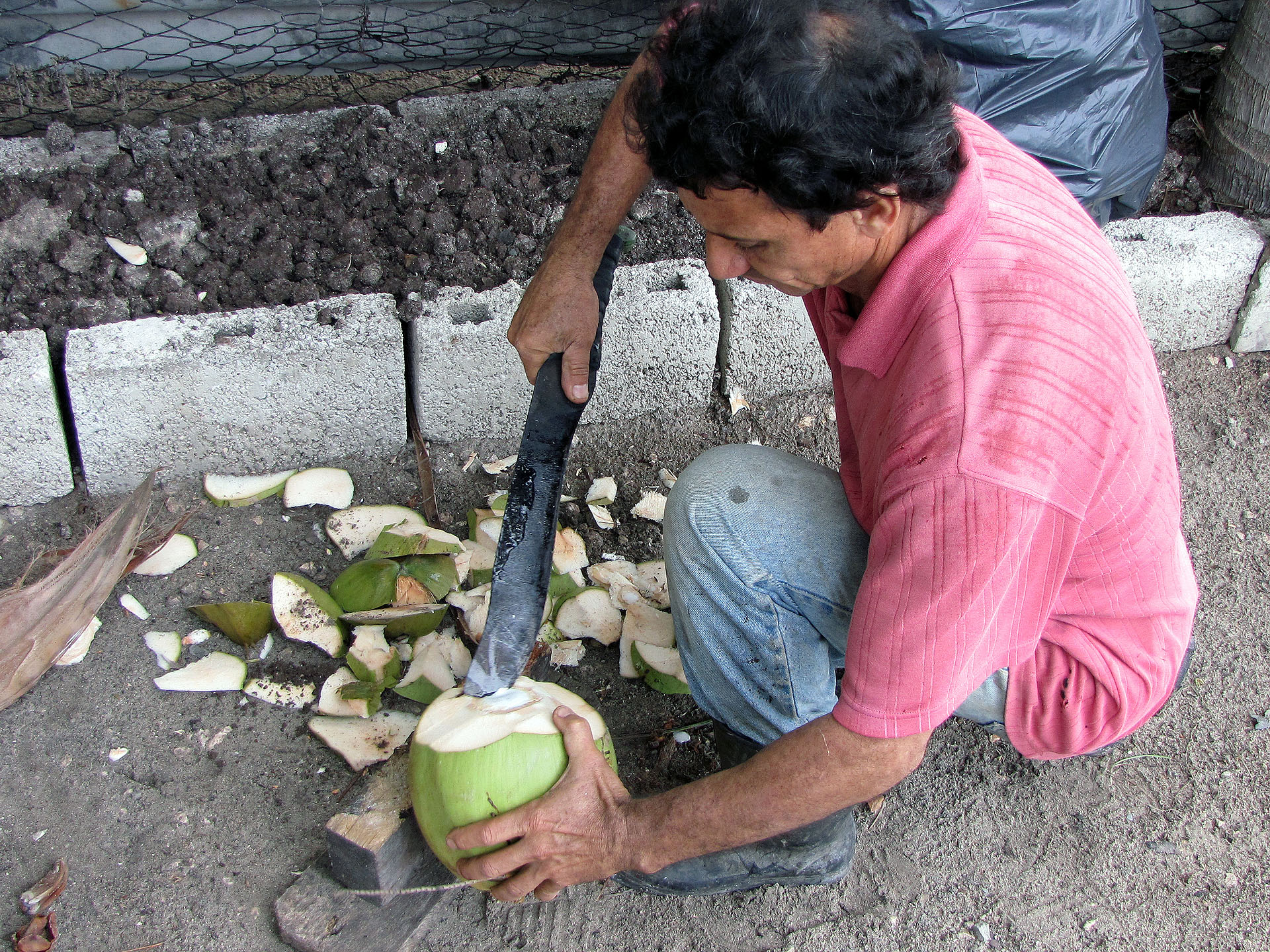 |
| Braulio is preparing a coconut for us |
A lot of Cubans, including some hotel workers, asked us
specifically for children’s clothes and towels. Another item that caught their
attention was our re-usable, colourful bags, sold in Canada by almost all major
stores. Although it was possible for Cubans to buy a lot of things in Cuba if
they had CUCs, prices of many items were quite high in comparison to those of
the same items in Canada. That was why I thought that perhaps it would not be a
bad idea to give them, in lieu of pecuniary tips, quality gifts which would
have been worth twice or thrice as much in Cuba. When we asked one Cuban about
what people in this neighbourhood needed the most (and he happened to be
relatively well-off by Cuban standards), noticeably surprised at our question,
he said,
 |
| Very photogenic residents of Tararaco |
“Whatever you can give them, they
will be happy to accept, most of them have nothing and they will be grateful
for anything they get. You have no idea how poor many of them are, living in
squalid, primitive conditions.”
Unfortunately, there is a huge (and possibly escalating)
disparity between those Cubans having access to the hard currency (be it
through work in the tourist sector or relatives abroad) and those subsisting on
the almost worthless Moneda Nacional
and earning over $10 per month. We were also told that gifts given by tourist
directly to schools sometimes never reached the schoolchildren, ending up being
sold by the school staff and even school principals had been fired because of such
practices.
Once we stopped at a stall where, under a big tree, Cubans
were selling various arts and crafts (north of the hotel, vis-à-vis El Rapido, close to the entrance to the
marina from which the snorkelling catamaran departs). One of them, Oscar, a
philosophically oriented man, spoke English well and we spent well over one
hour chatting with him. Such personal encounters greatly enhanced my Cuban
vacation and were always very memorable and enlightening.
Some Cubans who spoke English asked us if we had any
magazines, newspapers, books or dictionaries in English and I happily gave them
“The New York Times”, “The Globe and Mail” as well as a few recent issues of
“The Economist”. When we fly Cubana, we can bring almost 50 kg of luggage per
person, yet other airlines are not nearly so generous when it comes to baggage
allowances.
We talked to one Cuban about the Internet and about reviews
tourists post online. He said that there had been one Cuban fellow who used to
cook sumptuous (lobster?) dinners for tourists, yet he did not have a proper
permit for such activity. Apparently a lot of contented vacationers mentioned
his name & location online; as a result, the authorities found out about
his ‘restaurant’ and quickly shut it down.
None of the Cubans we met had access to the Internet and
most had only very vague idea on how the Internet worked and how critical and
essential it had become in our everyday life. Many Cubans we spoke to, especially
those having business dealings with tourists, did not fully realize that the
Internet might also have a huge impact on their businesses because of reviews
posted online.
There were plenty of taxis, horse-drawn buggies and bici
taxis on the hotel property or just near the road leading to the hotel. I did
not know how busy they were, but each time we were leaving and coming to the
resort while bike riding, we saw dozens of such vehicles idly waiting for
customers. Taxi drivers wanted from 50 to 70 pesos to go to Camagüey (7 pesos
less just to the airport); if hired for the whole day, it would cost about 100
pesos. Buggies charged about 20 pesos to take you to and from the village of La
Boca (yet prices depended upon the number of people and whether or not they
were going to have a lobster dinner there, as well as one’s negotiating
skills).
OUR EXCURSIONS FROM THE RESORT
Rancho King
Since we had booked our vacation through Hola Sun, one of
the perks we got (in addition to staying in the Hola Sun section, getting a
free bottle of rum and not having to pay for the room safe) was a free trip to
Rancho King (I believe it normally costs about 35 pesos per person). After a
bus ride we arrived at the ranch, where we were welcomed by 5 horse-riding
cowboys and then were taken to a small herb garden and given a very informative
presentation on various herbs and its healing properties.
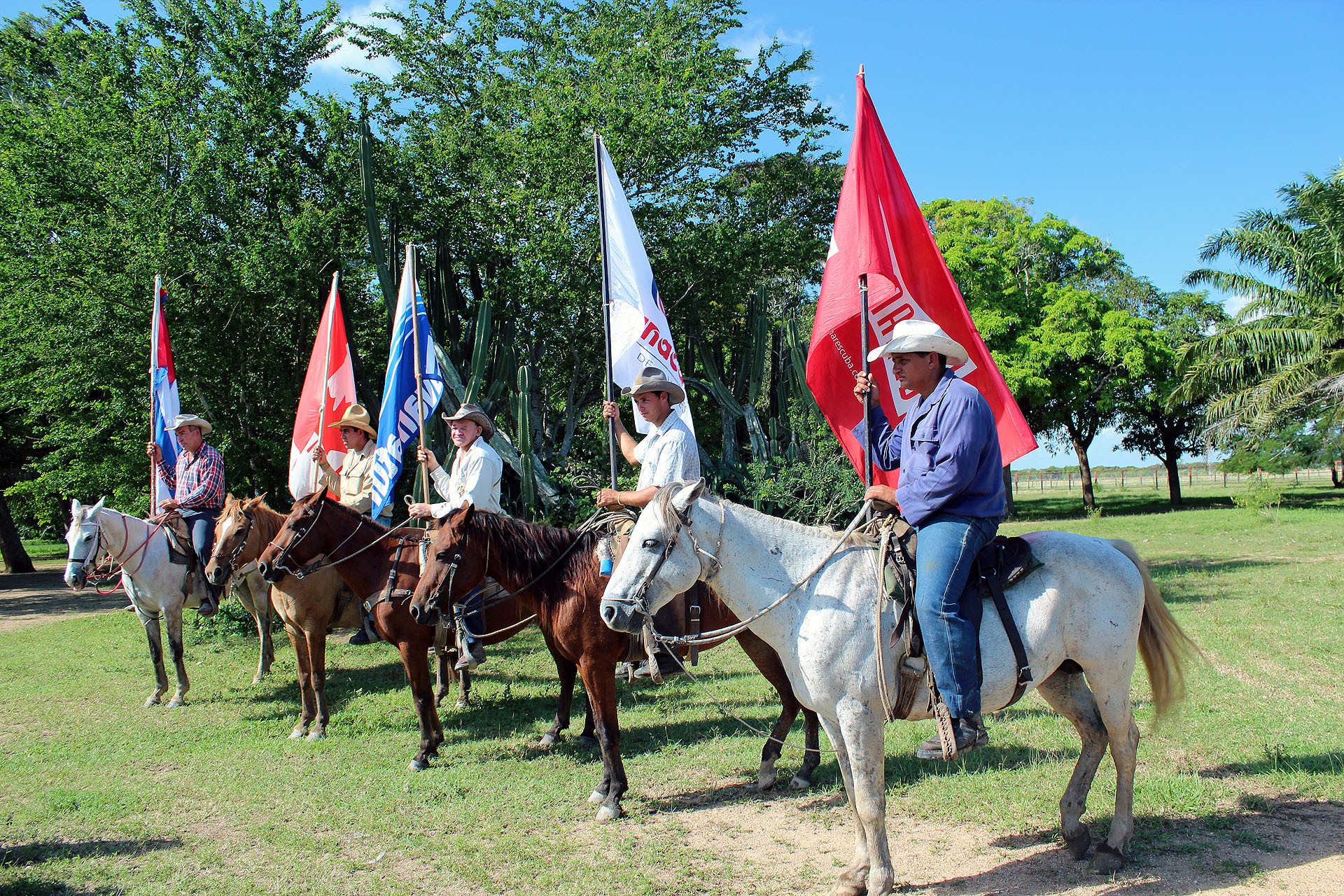 |
| Welcome at Ranch King |
During the ‘special
period’ (‘periodo especial’) after
the collapse of the Soviet Union, Cuba faced severe shortages of everything,
including medicines and thus herbal and natural remedies became quite important
and widely used. “Hallelujah for that!” said Catherine. As we wondered around
near the dining hall, we saw an old man hand-turning the stick on which a whole
pig was mounted and it was being roasted over the open fire; some Canadian
guests kindly bought him a can of cold beer for which he was grateful. Then we
watched a rodeo which was my first. A few people, including Catherine, did not
like it as they thought the animals were terrified for our entertainment.
Next
we proceeded on foot to the nearby village, followed by a bunch of locals,
reaping gifts from tourists who supplied treats and school supplies. We stopped
at a Cuban house (Fidel Castro had spent a night in one of its rooms once)
where we were given another illuminating presentation on the history of the
ranch and demonstration on extracting water from sugar cane as well as offered
coffee and fruits.
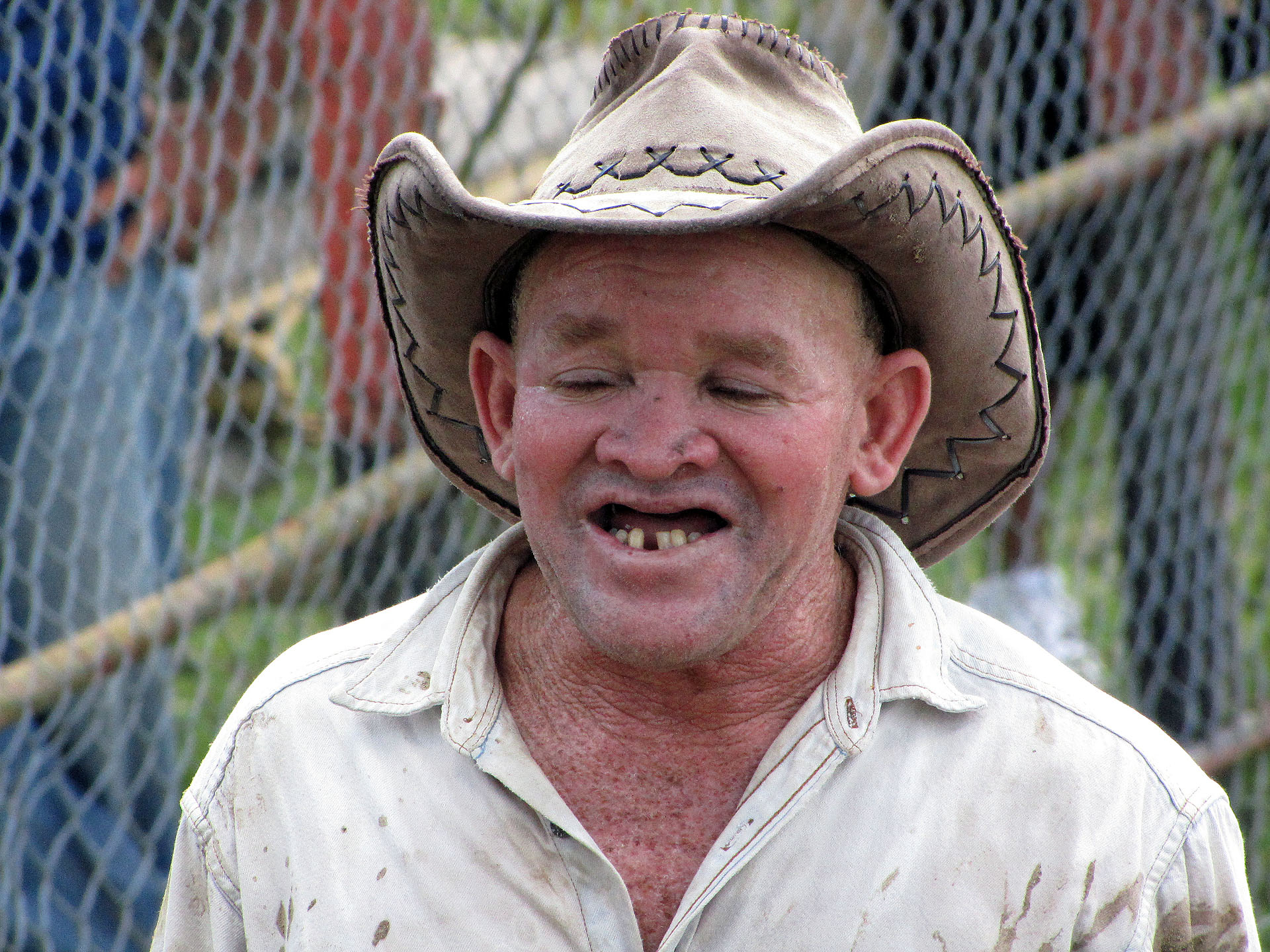 |
| One of the cowboys |
There was a group of American tourists, taking part in a
legal ‘educational’ trips to Cuba; we briefly spoke to them and they were quite
astounded at how little we paid for our vacation — theirs cost almost $5,000
for one week (per person)! A small school was located just across from the
house and people were able to distribute directly to schoolchildren whatever
gifts they brought. We headed back to the dining room for lunch; of course, the
main dish was the roasted pig! Overall, it was an enjoyable and informative
trip… and free!
The Catamaran Snorkeling
Tour
It could be booked thorough a rep outside the hotel shop (in
our case, it was Jose) and cost 25 pesos per person. We inquired beforehand as
those tours were not always a go, depending on the number of participants and
the weather. Incidentally, a several days earlier, Catherine offered to pay a
hotel sports-worker to take us out on the Hobie Cat for a reef snorkel, as it
was a calm afternoon, but he declined. She had the feeling that the staff had
been instructed to encourage people to sign up for the tour. The bus picked us
up at 10:00 am (Cuban time) in front of the hotel and after a very short drive
we boarded the catamaran which was docked in the marina north of the Mayabano
Hotel.
Designed for snorkelling/scuba diving, it was very spacious and even had
a bathroom. Equipment was supplied, although most of the guests brought their
own. Also water and soft drinks were free onboard. After about a 30 minute
ride, we reached the reef where we could snorkel for one hour. Once I got off
the catamaran, I became mesmerized by the colourful reef, forgetting about
everything and everybody else. The water was very clear and I saw plenty of
vivid corals and many fish yet did not see any star fish, urchins or
barracudas. The water was rather shallow. Catherine, being Catherine, swam so
far from the catamaran that one of the crew members began swimming with a life
float to get her (perhaps he thought she wanted to abscond to Miami…). I
brought two cheap, disposable underwater film cameras and took almost 50
photos, but as I expected, they did not turn out well. Overall, it was a great
trip and I would love trying scuba diving in Cuba!
Buggy Trip to the
Village of La Boca
The village of La Boca, located some 8 km north of the
hotel, could be reached by a potholed, unpaved road. We thought about bike
riding there, but considering potential mechanical problems with the bikes and
possibility of walking back in the dark, we decided against it.
On December 3,
2013, we were approached at the beach by a tall Cuban cowboy who asked if we
wanted to take a horse & buggy to La Boca for $20. We (make it Catherine)
agreed without bargaining and the next day at 2:15 pm o’clock we got into the
buggy and trotted off to La Boca. We also gave two hamburgers to the buggy
owner and his young nephew (who, by the way, was learning English and his teacher
was Braulio, the Organic restaurant owner whom I previously mentioned). The
road was rutted, but the ride was quite comfortable and the drivers knew how to
avoid grooves and potholes. We arrived at La Boca before 3:00 pm and were
dropped off at a large restaurant, near a beach. Catherine wanted to see
flamingos which the coach owner said would be there, but it turned out they
were always gone at this time of the day, so she felt a little cheated as the
cowboy had assured her they were spectacular then.
It was very sunny, so we took a shelter on the sand (read,
no loungers) under a lone palm tree on the beach, sipping a still cold can of Bucanero we had brought with us and
chatting with an eager guitarist, playing (fairly well, in my opinion) “The
Hotel California”. We gave him a few sandwiches and bananas we had packed from
the hotel for our snack as well as some soap and he truly felt happy. Another
Cuban couple approached us; they looked like proselytizers and I thought they
would be sharing some religious enlightenment with us and attempting to convert
us to their faith, whatever it was, but they only asked us if we wanted to have
a delicious lobster dinner.
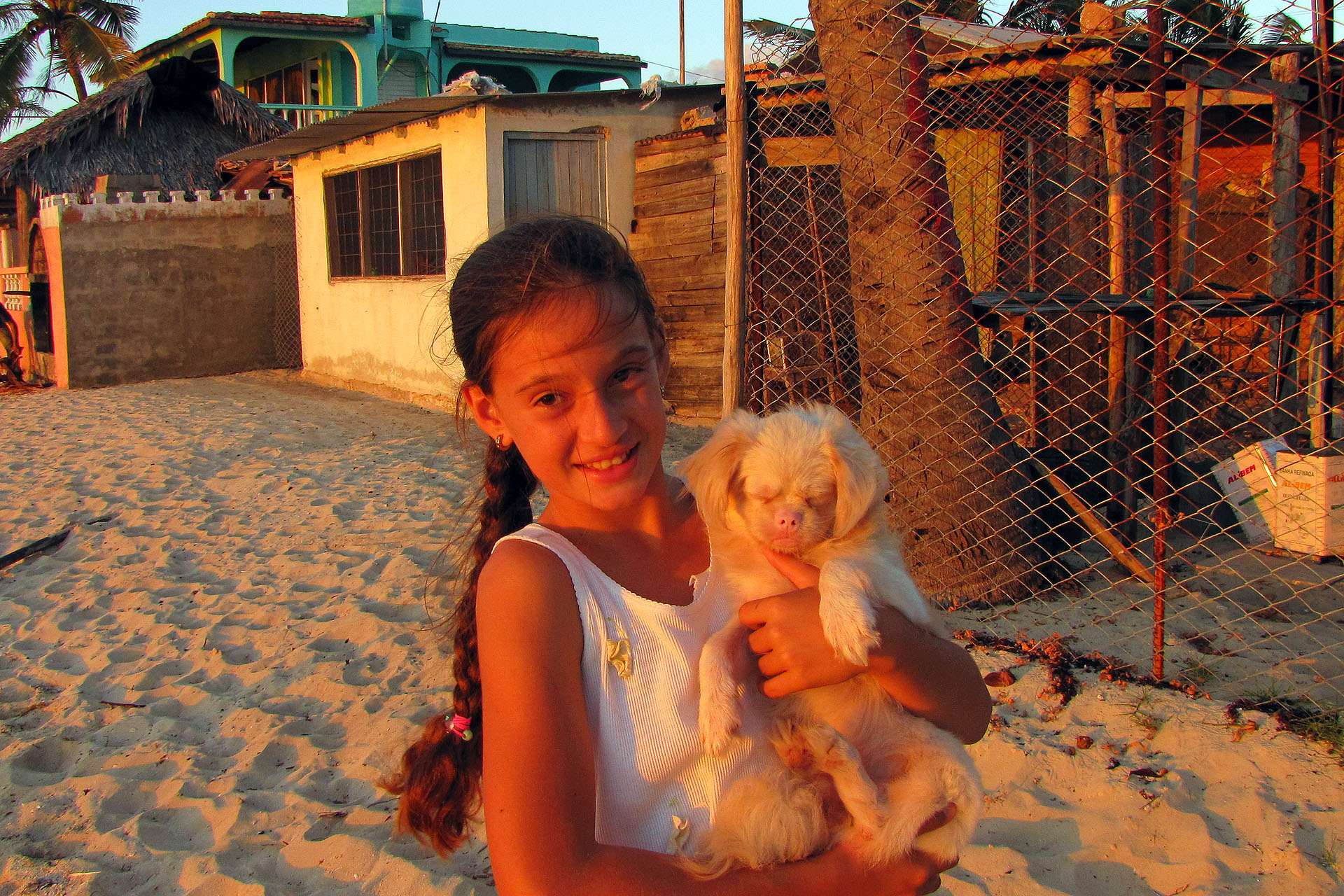 |
| Girl in La Boca with a puppy |
There were a few de
rigueur propaganda posters/graffiti in town which I eagerly photographed.
La Boca also had a few casas particulares.
While we were standing on the shore and observing the setting sun, our coach
driver materialized and explained that we would depart ½ hour later (i.e., at 6:00 pm) with another group
which was having lobster dinner at the village. Catherine was a little upset,
as she suspected the buggy driver must have planned that from the outset and
was afraid a Cuban half hour will turn into much longer, making US dinner for
mosquitoes, plus we would be squeezed into the buggy with 2 other couples. In
fact, she was ready to renegotiate the 20 CUC price. So, we waited on the rock
outside the “Dinner House” — not that I minded that much, as I was still trying
to take photos — and eventually the coach driver showed up and got us. We rode
back with a couple from Toronto and talked with them on the way back; another
buggy, full of tourists, followed us.
Catherine asked to sit up with the driver, as the bugs were biting and there was a breeze up top. She had a wonderful view of the darkened sky too. When we were approaching the Hotel Mayabano, both buggies suddenly turned into a dark road. We were told that there were police in front of the Hotel Mayabano — and since horse-drawn buggies were not permitted to be on the road after 6:00 pm, they had to take back roads (as a matter of fact, none of the buggies had any lights whatsoever, which was a little discomforting while we rode on that bumpy road in total darkness). The back road was very sandy and not only did the horse have problems pulling the carriage, but it also got scared and a few times did not want to budge at all. At one point all of us had to get off the coach so the driver could re-position the buggy and persuade the horse to keep moving. Eventually we reached the Caracol and paid the agreed 20 pesos — incidentally, the couple said that they paid 15 pesos per person, which included the lobster dinner (yet we did not really care too much for the dinner anyway). It was a wonderful trip and its highlight was walking along the beach, taking photos and especially interacting with the local residents. I am looking forward to visiting this lovely village again!
Three Day Trip to the
City of Camagüey
It was our private trip, as it was possible to take an
‘organized’ (and pricy) trip from the hotel. There were always several taxis in
front of the hotel and I had been asking them how much they wanted to get us to
Camagüey — prices varied from 50 to 70 pesos. By the way, it was possible to
get to Camagüey on one of the tourist buses going from the resort to the
airport, but we would have to negotiate the price with the bus driver and
sometimes buses could be full; besides, we would still have to get a taxi from the
airport to the city center (7 pesos).
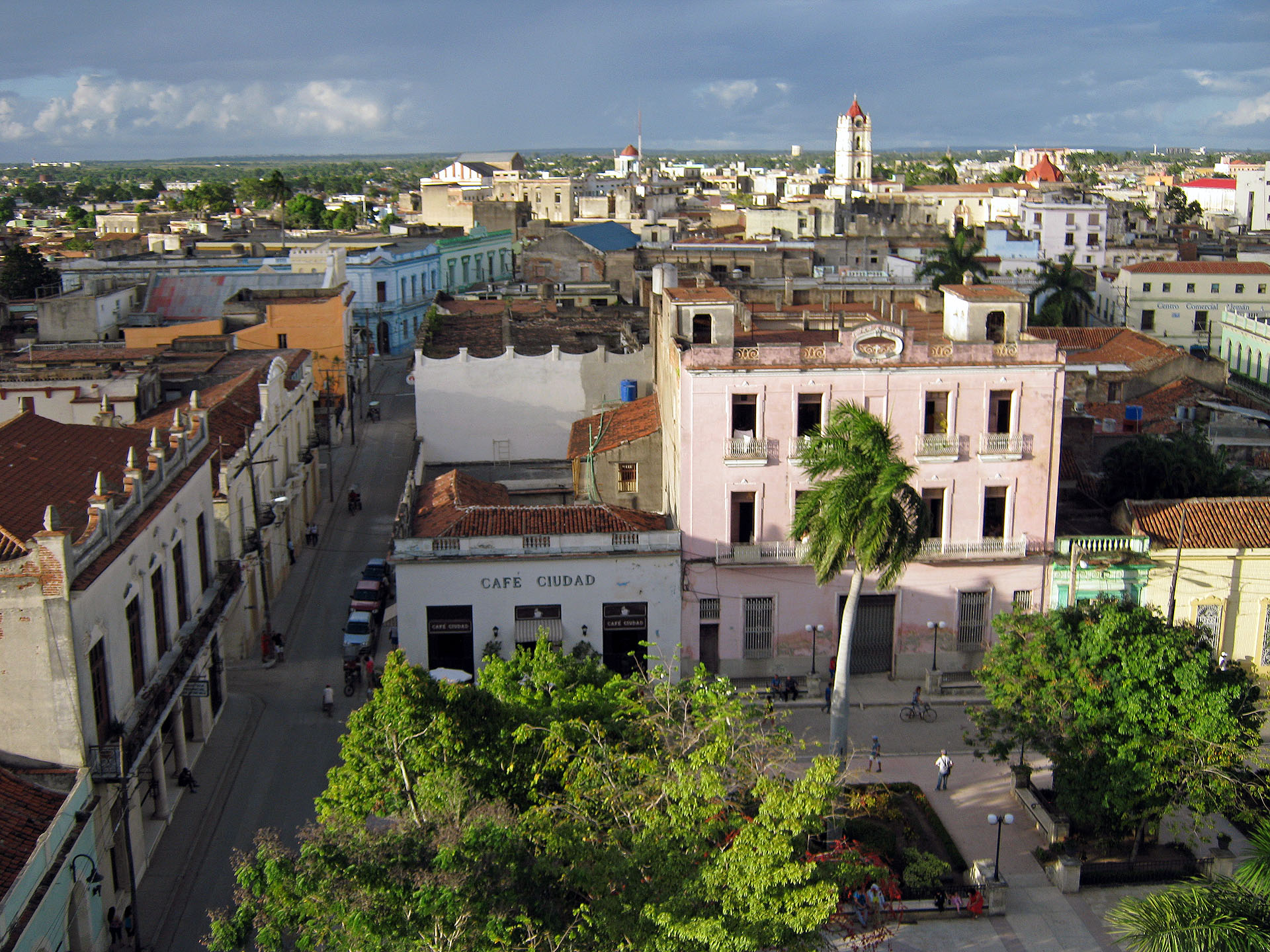 |
| View from the Cathedral on the main plaza |
The land was flat, with hills popping here and there. We passed farms; some were now private and doing quite well. He told us that he had been in the Cuban army and he had been fighting in the Ethiopian-Somali war in 1977/78. Frankly, I knew nothing about this war and Cuban involvement and only after coming home I did some perfunctory research: the Cubans, about 15,000 combat troops, were fighting along Ethiopians and 400 Cubans lost their lives. Well, another conflict that most likely resolved nothing…
Before leaving for Cuba, I had printed plenty of reviews
& addresses of various casas particulares in Camagüey. We could not
call the casas as there was no
telephone number provided. We told him
to drive first to Casa Particular Los
Helechos. He had a difficult time finding it — Camagüey is famous for its
maze-like streets — and the map was not helpful at all. When we finally found
it, its owner said the casa was
occupied and he did not offer any suggestions or recommendations.
“A friend of mine has a nice casa,” our driver said.
“OK, get us there,” we said,
trusting in his judgement and envisioning a similar casa to the ones we had read about on TripAdvisor.
We were absolutely shocked at how decrepit everything was at
that casa (which, predictably, was unoccupied-undoubtedly
for a long time…). Catherine quickly used the bathroom and discovered there was
not running water in the faucet. She asked the owner about the shower and
learned that not only did it dribble, but we had to manipulate some wire to
heat it first. The rooftop (where we anticipated to have meals and relax) was
just that — a roof with no chairs, no plants. The room was dark, dingy and
disgusting, its windows faced a noisy street and the shutters were on… in
short, it was a terrible casa. We
politely said ‘no, thank you’ and asked the taxi driver to drive to another casa that was on our list, Casa Caridad.
As of August, 2014, it was ranked number 1 of 22 casas in Camagüey in TripAdvisor [Oscar Primelles (San Esteban) 310-A Entre/
Bartolome Maso (San Fernando) Y Padre Olallo (Pobre), Camagüey70100]. As
luck would have it, the proprietress of the casa
(her name was Caridad) was just arriving home, so we spoke with her and she
rented us a nice room. We were so happy. She told us to wait 5-10 minutes
before registering us as she had to go out with her grandchildren. In the
meantime, the taxi driver went out to park his cab in front of the building and
unload our bags — it took some time because of the network of one-way streets.
As we were waiting, a group of 4 French speaking people arrived and suddenly we
were told by the proprietress’s husband that there was a misunderstanding and
there was no room for us. We were, least to say, disappointed, and the taxi
driver, who broke the news to us (as the casa
owners did not speak English), looked frustrated, as he wanted to return home. Miraculously,
before we left to look for yet another casa,
the proprietress showed up, gave her husband an evil eye and said firmly that
the French guests did not have a reservation, despite their claim of having
such — we were here first and we would get to keep the room. By the way, the
French (two couples) somehow managed to squeeze in the remaining room.
We were delighted and quickly moved into the room, knowing
that possession is nine-tenths of the law (on the second thought, I did not
think such law applied in Cuba — although this tenet had been successfully working
for the Americans in Guantanamo for many years).
We quickly settled in the room, which had a private bathroom
with a shower as well as a working air conditioning. Right away the owner
offered us supper and we accepted, telling her that we would come back in the
evening, as we wanted to explore this beautiful city and in no time we hit the
streets and pavement.
And what streets they were! Extremely narrow, one-way,
maze-like, with many dead-ends which would stump the smartest rat on the block,
and with even narrower sidewalks dotted by open holes and sizable cavities,
often with lamp post in the middle. Walking down those streets was an amazing
experience in itself.
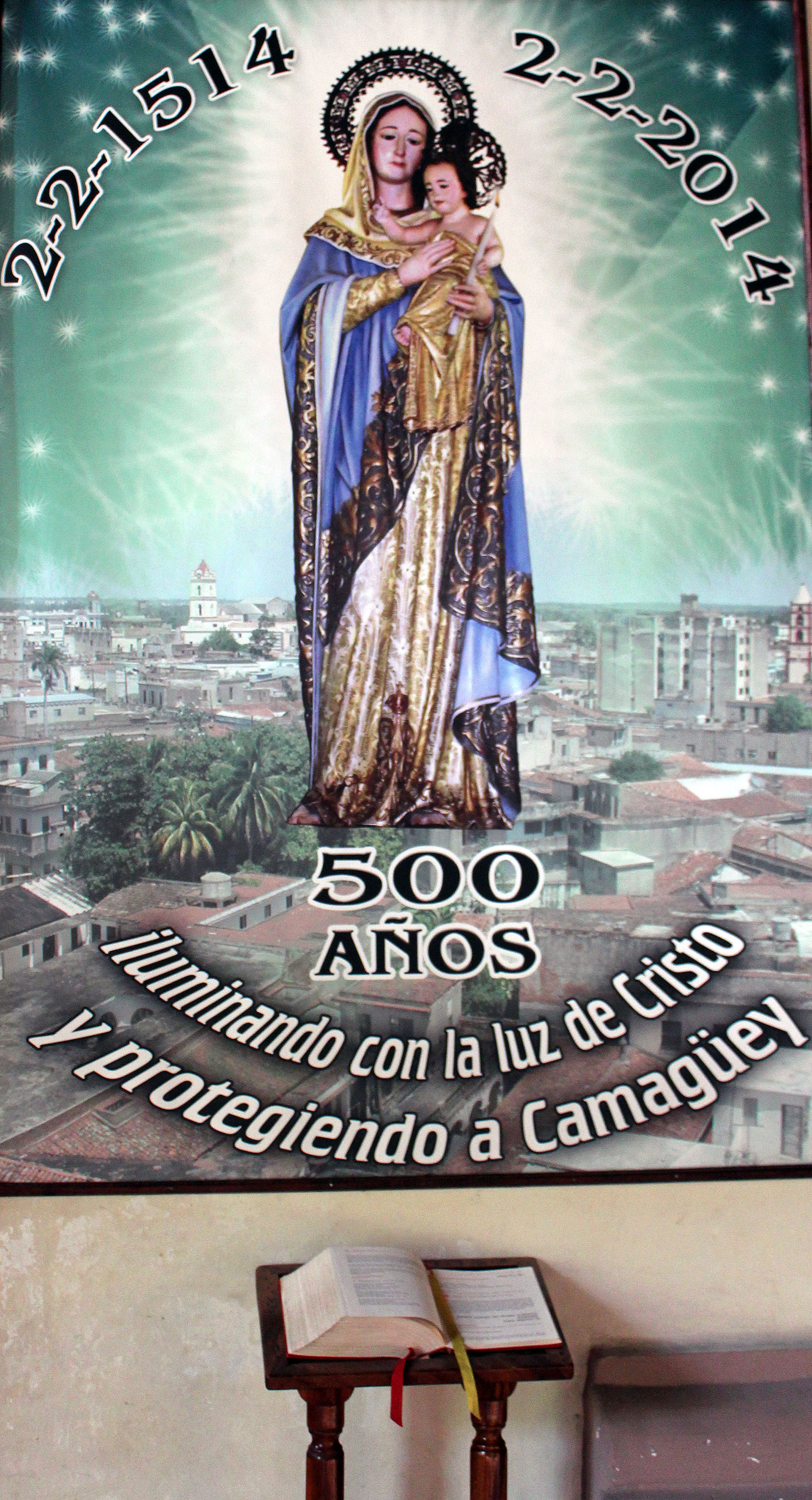
Supposedly the streets were designed on purpose, to make
the city easier to defend from raiders — or, in case the pirates did manage to
enter the city, then they would have an even tougher time finding their way
back, thus enabling the city inhabitants to entrap and dispose of them. Yet
some say it was just a bad design and the city was developed without any thought-out
strategy or planning. As a matter of fact, the city of Camagüy, the fourth established
by the Spanish in Cuba, was about to celebrate its 500th birthday — it was
founded on February 2, 1514 — not too many cities in the America can boast such
an anniversary!
Oftentimes, people were sitting on the steps leading to
their massive colonial-style doorways and we had to step into the street to get
around them. Cars, truck, motorbikes and bikes were parked on the streets,
making it very difficult for other vehicles to pass by. Most of the cars were
driving very fast and emitting a lot of pollution. A couple of times I saw
cars/trucks (especially when they were making turns) almost touching pedestrians
or other vehicles. Nevertheless, we did not witness any accidents — only once a
cop was ticketing two young girls on a motorcycle. We asked Cubans what they
thought about tourists who rented cars and then drove in Camagüey. All of them
said that it would be much better for visitors to just hire a taxi cab instead
of driving cars themselves. While chatting with taxi drivers, I asked them how
much it would cost to hire a taxi for, say, one week — would 100 pesos per day
be enough? They said it would be absolutely sufficient and it would include gas
as well as accommodation & meals for the driver (who could sleep at ‘Moneda
Nacional’ casas particulares for
Cubans).
 |
| Traffic ticket |

We spent the next several hours just walking in Camagüey,
exploring the torturous, narrow, zigzagging and suddenly ending streets,
admiring its many impressive buildings and churches, exploring plenty of plazas
& plazuelas and just sitting in a
café, sipping beer or cappuccino, while observing passing people. We saw at
least 4 impressive catholic churches, including the Cathedral (Iglesia Catedral de Nuestra Señora de la
Candelaria). The map of Camagüey sold in stores was not good at all (as one
Cuban said with disgust, upon seeing it, ‘muy
malo’), it did not show the city center and a simple printed Google map was the best, we had one and it was very convenient (until we lost it the first day) — just keep in mind that many streets had new names (which the map shows), yet the old names were not only commonly used, but the original, pre-revolutionary street name signs, were still everywhere. Calle Maceo was turned into a pedestrian passage and we enjoyed
strolling along this vibrant calle, visiting
various stores.
There were old, pre-revolutionary solid fire hydrants, but they did not work anymore. On some streets old streetcar tracks were still intact.
There were old, pre-revolutionary solid fire hydrants, but they did not work anymore. On some streets old streetcar tracks were still intact.
Walking down those streets was just delightful! There were
some signs showing us where we were and where to go and somehow we never got
lost, even though supposedly most tourist do. We visited the Cathedral and
Catherine went up the spiral stairs to its upper floors while I was exploring its
interior. When we arrived at Plaza de San Camagüey. He was beatified by Pope Benedict XVI and the
beatification ceremony took place in Camagüey, presided by Cardinal Jose
Saraiva Martins and the President of Cuba, Raul Castro, attended the ceremony.
Juan de Dios in front of a church
where father José Olallo y Valdés (1820 – 1889) used to care for the poor of
the city of Camagüey
There were many stands selling Cuban souvenirs at the plaza
and I purchased a few small gifts. We were approached by a comical and highly
animated, diminutive fellow. He showed us a piece of paper with a list of
various countries and signalled us to point out which country we were from. I
pointed to Canada. Once it was established, he went to his other ‘file cabinet’
containing alphabetical index cards, opened the “English” file, pulled out a
piece of paper and showed it to us. It contained the following information in
English:
“Please excuse me one
moment. I am deaf and mute. Please help me. I don’t have any thing and any
work-your assistance would be very important for me. I truly hope you enjoy
your stay in my country-many thanks for your time. Pedro Dita.”
Wow, what an organized guy — he certainly surpassed
Toronto’s homeless & beggars in his ingenuity!
Once we managed to divest ourselves of him, another young
man about 25, E., approached us, talking to us mainly in Spanish (and often
incoherently). He seemed to be a little unstable and agitated, but we could not
get rid of him, so we just let him accompany us. We walked with him — or rather
he followed us — later visiting a very plain coffee shop, frequented by Cubans,
where it was possible to buy coffee, beer, cigarettes and other drinks with
Cuban pesos. We did not have any Cuban pesos (i.e., ‘Moneda Nacional’), but we quickly exchanged one ‘peso convertible’ into over 25 Cuban
pesos and bought a small cup of black coffee (it was just 1 Cuban peso, or
about 4 Canadian cents), beer (18 pesos) and cigarettes (about 7 pesos). Then
we proceeded to the Theatre near Plaza de los Trabajadores; there was a
performance by young children and the audience was made up mostly of their
parents. We went to a nearby coffee shop and bought several cans of Bucanero, including one for him, but he
wanted a Cuba Libre (i.e., rum &
coke) — I told him to drink the beer. He said that his parents were dead as a result of ‘an accident caused by heart problems’ (whatever it meant). He kept telling us about his daughter (he was not married) that also had heart problems and was in a Havana hospital; when I was taking photos outside, he constantly bugged Catherine to give him some money. He was kind of amusing, but bothersome and we just could not shake him off — he wanted us to take him to dinner in a restaurant (i.e., intended us to pay for his dinner). We finally gave him some gifts and made it clear we were going to our casa particular and that
he was not invited. Since I took several photos of him, I promised him
to mail them to him, so he gave me his address. A few month ago I did mail them
to him — lo and behold, he wrote me a letter!
[Here I would like to add that during our second trip to Camaguey in October/November, 2014 (http://ontario-nature.blogspot.com/2015/12/trip-to-santa-lucia-cuba-two-weeks-at.html), we again met Mr. Pedro Dita, the mute/deaf guy--he did not recognize us and again pulled out the same piece of paper in English! We also met the other guy, E., or rather he spotted us, started to follow us while shouting something incoherently and it was impossible to have any conversation with him. Eventually Catherine mentioned "Police" and he immediately vanished. I felt really sorry for him, but he certainly had some mental issues].
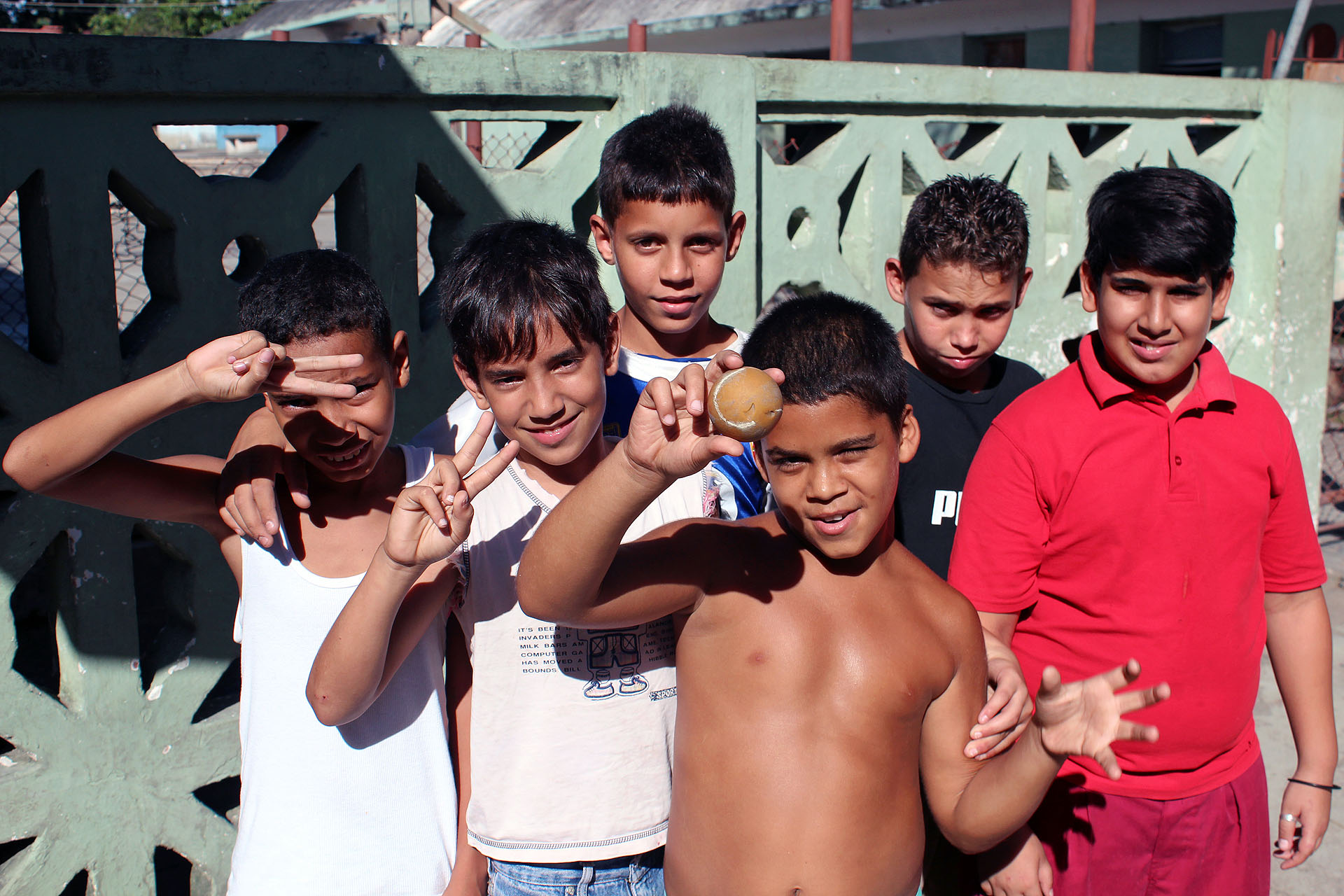 |
| Kids near Casa Caridad |
“It is not fair that you can travel
and I can’t,” he said, “it’s not fair that I don’t have access to the Internet,
can’t read western newspapers, and can’t enjoy the freedom you can.”
I could perceive that he was really disillusioned with the
way of life in Cuba. I understood him quite well. Cautiously, he added:
“But the
current president of Cuba [Raul Castro] is much bolder than the previous one,
in terms of making changes.”
We later wished we had hired him as a guide the next day,
probably we could have learned a lot from him about Camagüey and life in Cuba
in general.
Another Cuban we met, quite an intelligent and interesting
gentleman, who spoke quite English quite well, was not satisfied with the
political reality either.
“I have built a cocoon in which I
live,” he said, “and thus I can be isolated from the events that take place
around me in this country. I try to focus on reading books, talking to
tourists, meditating…”
The only good thing was that the Cuban government had also
realized that the system could not survive in the present form and that was why
more and more changes had been introduced, Cubans were encouraged to set up
businesses and become self-employed instead of relying on getting government
jobs. It will be interesting to see how those changes will transform Cuban
society and economy, but no matter what, it will be a long, difficult, full of
obstacles and very bumpy road!
We walked to the train station (Terminal de Ferrocaril); once I entered it, I immediately had a
feeling of déjà vu: plain, filthy waiting
room, with built-in, solid benches, full of sleeping and sweaty people, waiting
for trains that were either notoriously behind schedule or never arrived at all
— how many times I myself had spent waiting for hours at similar train stations
in Poland! It was a pity I did not have a camera, those photos would have been
priceless. As we were leaving the station, I saw a train and it was the first
train I had seen in Cuba — I think this is the only Caribbean country that had
trains.
Exhausted, we went back to our casa; I drank some water (there was a fridge in our room, full of
various drinks for a price — but it was cheaper to buy our own in the city),
had a shower and we turned in.
We were up early in the morning and on December 1, 2013, went
to the Sunday morning (9:00 am) mass in the Cathedral. Probably we were the
only tourists attending the mass. Although I could hardly understand anything,
the mass followed the same order as that in Canada. The only difference was
with the collection: instead of passing the collection basket, all attendees
stood up and approached church ushers near the altar who held collections
baskets. Of course, my donation consisted of ‘real’ money, i.e., convertible pesos
and I noticed that the usher was quite startled when she noticed my collection
of 10 pesos.
 |
| Parque Agramonte and the statue of Ignacio Agramonte; the Cathedral on the right |
As I went outside to take photos, suddenly I saw our deaf
mute ‘friend’ from yesterday! Upon seeing me, he acted as if we had been the bestest
friends for ages and almost embraced me; then he began energetically waving his
hands and pointing to his mouth and tummy, hinting that he was hungry and
needed to eat something.
 |
| Our 'friend' |
We encountered many Cubans selling fruits and vegetables
(Catherine bought bananas and oranges — the vendor was more than happy to
accept chewing gum, pens and other small gifts in lieu of money). We also
observed a group of Cubans playing domino — it was a popular pastime in Cuba.
One guy was selling apples and oranges and peeling them, Catherine bought some
as well.
 |
| Paining by Roberto Brigido Suri |
We also decided to visit a cemetery (Cementerio General de Camagüey), located not far from the city
center. On the way there we dropped in to a nice restaurant called “La
Tinajita”. Its name was derived from the famous clay pot, or ‘tinajón’, used to capture rain water to
be used later, keeping it fresh. The ‘tinajón’
is the symbol of the city and we encountered them everywhere, some very small,
others big enough to hold a few adults. It is said that if you drink water from
a girl’s personal tinajón, you will
fall in love with the girl and never leave her. The restaurant server pointed
to one old tinajón inside — according
to an engraved inscription, it was made in 1838. In fact, later I purchased a
few small tinajóns as souvenirs. We
had a couple of cold beers and continued walking to the cemetery.
 |
| Salvador Cisneros Betancourt |
The tombstones at the cemetery were mainly white, some quite
old and distinct, apparently holding prominent individuals from the
pre-revolutionary period. We saw a couple who were solemnly standing for some
time in front of one of the tombstones and then slowly left the cemetery. Most
likely it was their son’s grave; according to the inscription, he died at the
age of 26. We spent almost one hour there, admiring amazing statutes, crypts
and mausoleums. One of the graves drew my attention as it must have belonged to
a very distinguished citizen of Camagüey. Its inscription (in Spanish) read: “El Ayuntamiento de Camagüey. Al Gran
Ciudadano Salvador Cisneros Betancourt. Nacio 10 de Febrero de 1828. † 28 de
Febrero 1914.” (The City of Camagüey. To Grand Citizen Salvador Cisneros
Betancourt. Born on February 10, 1828. Died on February 28, 1914). Only after
several months I found out that during the Ten Years’ War (1868-1878), during
which sugar mill owner Carlos Manuel de Cespedes and his followers proclaimed
Cuba’s independence from Spain, Salvador Cisneros Betancourt was President of
the Republic of Cuba in Arms from 1873 to 1875.
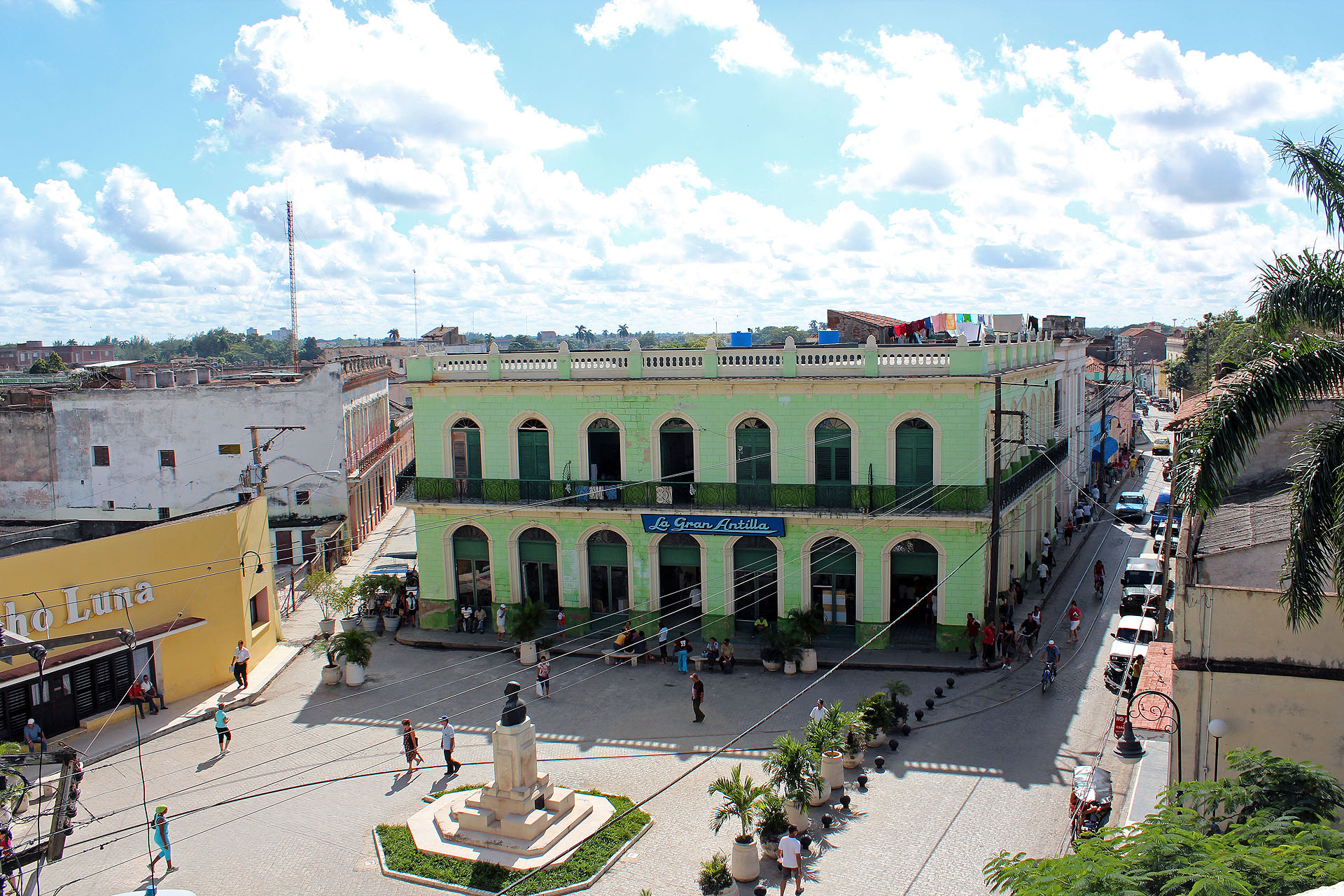 |
| View from a casa |
Our casa owner
wanted to serve us breakfast, lunch and dinner/supper — we only opted for the
dinner — after all, three meals per day were too much for us; besides, we
wanted to eat out in town, which also gave us an opportunity to mingle with
Cubans. We spent two nights in the casa
and the total bill, including the two dinners, came to 102 pesos. The casa proprietress said that her son had
a taxi and he could take us back to the hotel for 50 pesos — he had a relatively
new car (at that time itwas impossible for average Cubans to legally buy a new car — his was a second-hand, previously used as a rental vehicle), spoke English and we had a very nice and pleasant drive. Along the way he gave a lift to a uniformed Cuban cop; I hoped to strike up a conversation with him, but he did not speak English and probably preferred not to speak to tourists.
While we were waiting for the bus to take us to the airport
on the last day of our vacation, one guy brought (yes, he actually carried it
himself!) a fridge from his room and ostentatiously placed it on the reception
counter in the lobby.
It turned out he had had many problems with his room;
among other things, the fridge did not work and although he had reported this
fact a couple of times, nothing was done about it. So, finally he decided to
take (literally) matters into his hands and dragged the fridge to the reception
desk! Supposedly the hotel called security on him… Since we were leaving, I had
no idea what was the outcome, but I could certainly sympathize with him! Again…
‘es Cuba’!
Our plane was departing in the evening and we were supposed
to check out at 12:00 pm, yet the maid let us stay longer (after all, the maids
cleaned the rooms until about 3 pm). The hotel bus took us to the airport a few
hours earlier. While I joined a line to the ticket counter, Catherine was
getting the suitcases; Larisa’s husband Alex helped her out. Unfortunately, I
picked the worst, slowest line: all the tourists who joined other lines long
after us were processed and we were still waiting. Nevertheless, we got quite
good seats at the very back of the plane.
The airport at Camagüey had a well-stocked duty-free store
(not that there are any duties or taxes in Cuba anyway) where we made our final
purchases of alcohol and tobacco. Other stores at the airport had a good
selection of gifts and postcards at surprisingly low prices. I used my credit
card just once to make a purchase and had no problem, but some people did —
most likely they had failed to notify their credit card company about their
trip to Cuba.
I was glad we decided to spend, for the first time, 2 weeks
in Cuba — it gave us ample time to explore Santa Lucia & La Boca, visit Camagüey
and relax on the beach.
It was our sixth trip to Cuba in 5 years (since 2009) and
undoubtedly one of the best — not that we had had a bad one, all of them were
very good! We loved the hotel, food, staff, beach and the overall atmosphere.
The excursions allowed us to experience, at least partly, the real Cuba and
meet plenty of very remarkable and kind Cuban people. Although hitherto we have
never gone to the same resort more than once, we are considering returning to
the Caracol next year and re-visiting villages of Tararaco & La Boca and
spending several days in the city of Camagüey.
Blog po polsku/in Polish: http://ontario-nature-polish.blogspot.ca/2014/09/camaguey-cuba-w-hotelu-club-amigo.html
More photos from this trip: https://www.flickr.com/photos/jack_1962/sets/72157647698353620/
